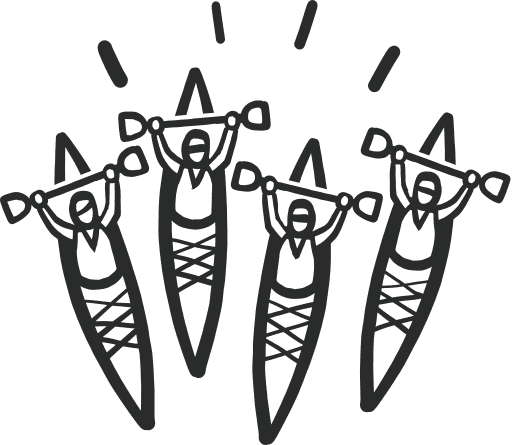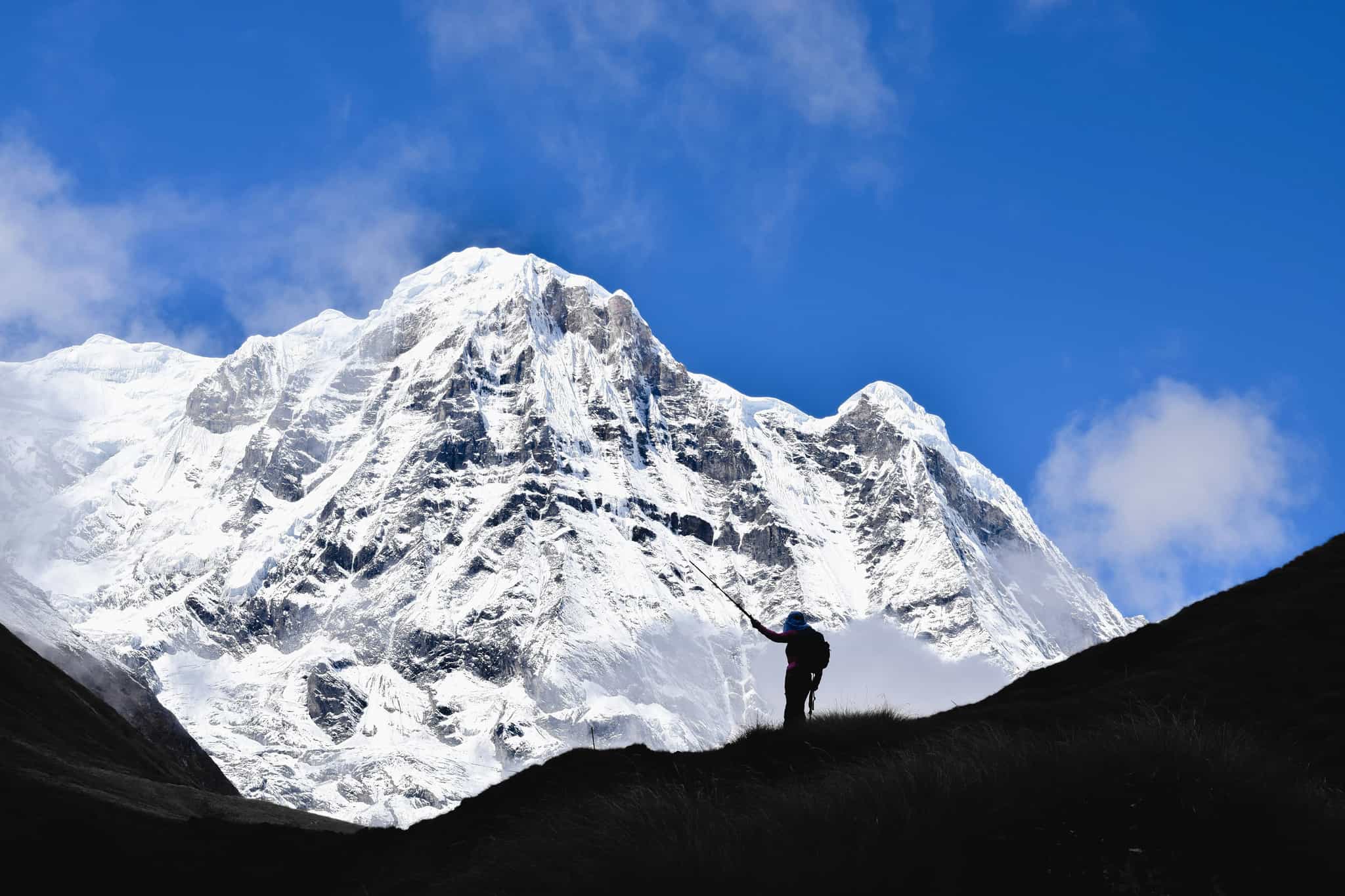
Trek the Annapurna Sanctuary Route & Go on Safari
Tackle a classic Himalayan trail among some of the world’s most incredible mountains and spot wildlife in the jungles of Chitwan
What's Included?
Activities & Certified Guides
All itinerary activities with local, expert, English-speaking guidesHotels & Teahouses
6 nights hotels in Kathmandu, Pokhara and Chitwan and 9 nights in local teahouses along the trekMeals
6 breakfasts, 2 lunches and 4 dinners are includedTransfers & Porterage
To and from the airport and everything in between, plus porterage of your overnight luggage during the trekPermits
All entrance fees and permits are taken care ofSmall Like-minded Groups
Solo-friendly by design, join our small n’ sociable groups of up to 12 like-minded, active and outdoorsy people…
…
What's it like?











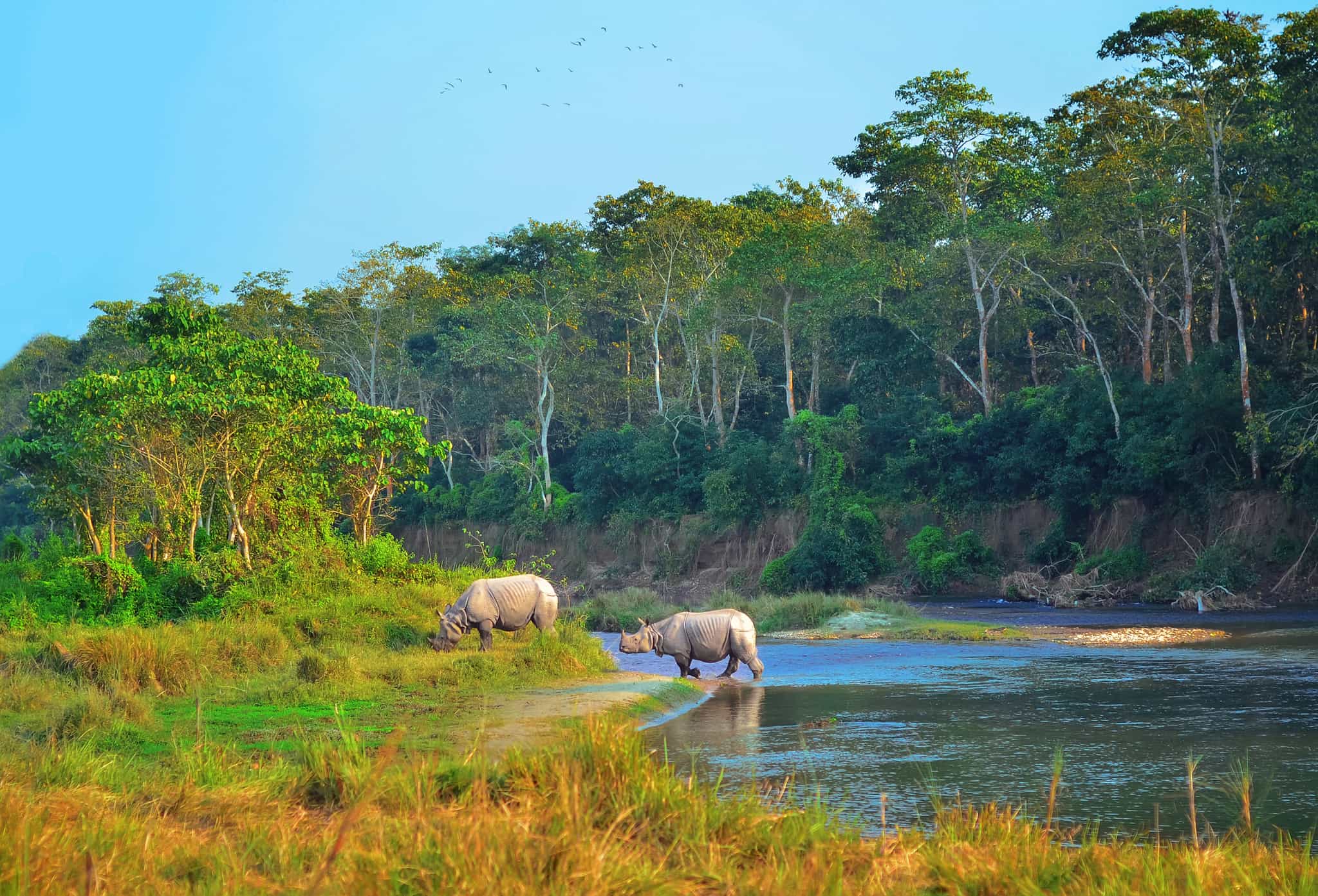
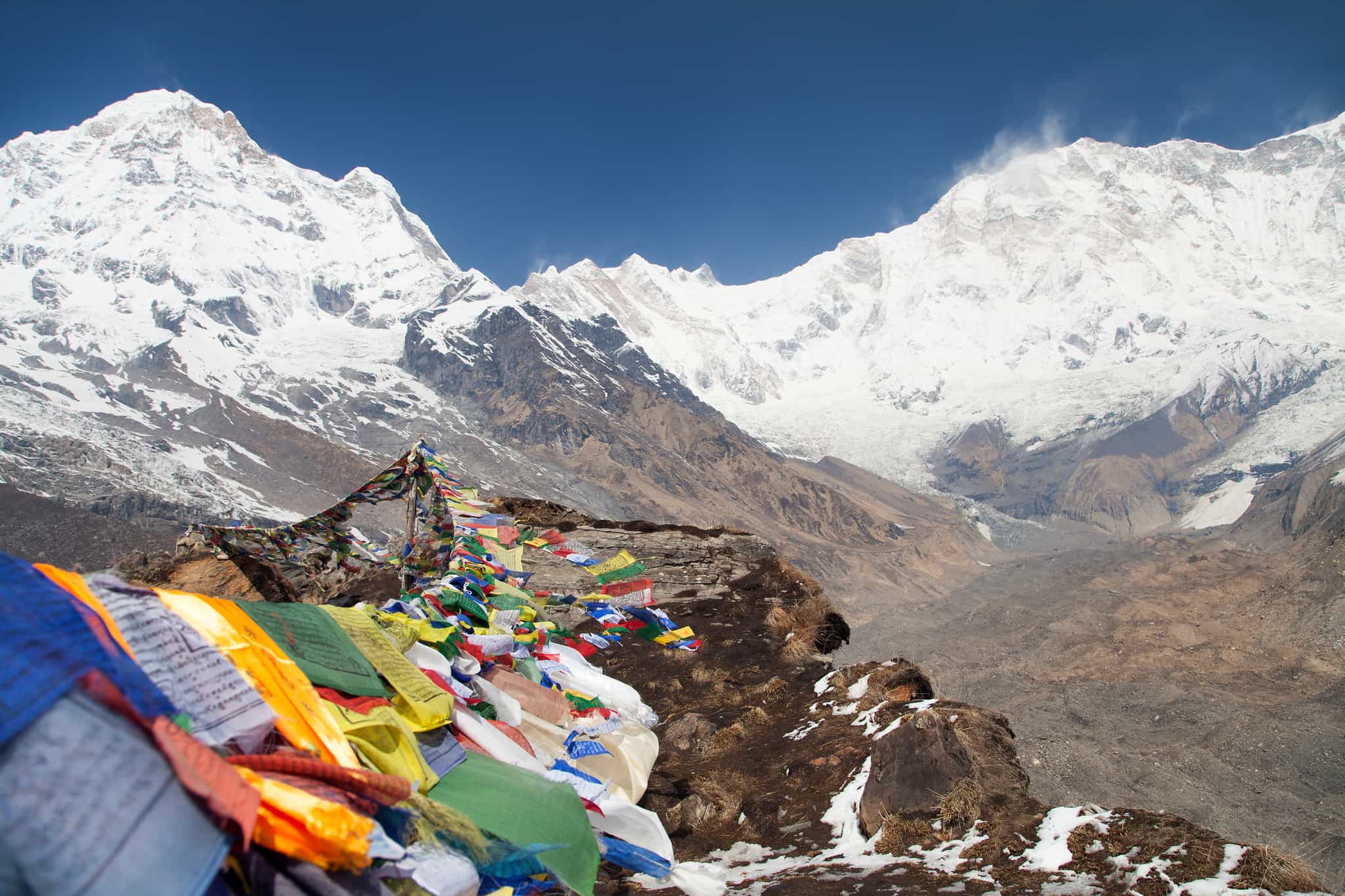
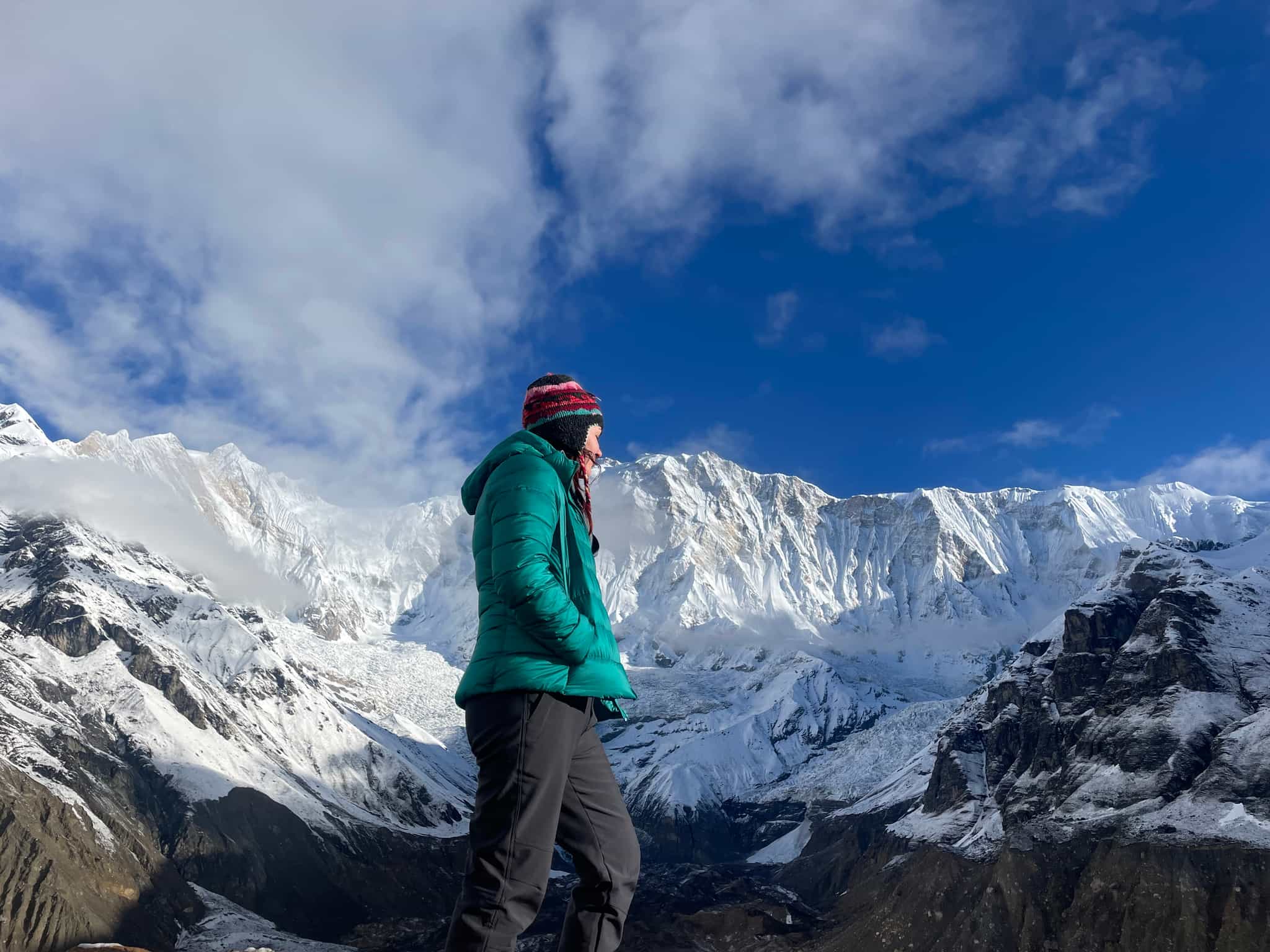
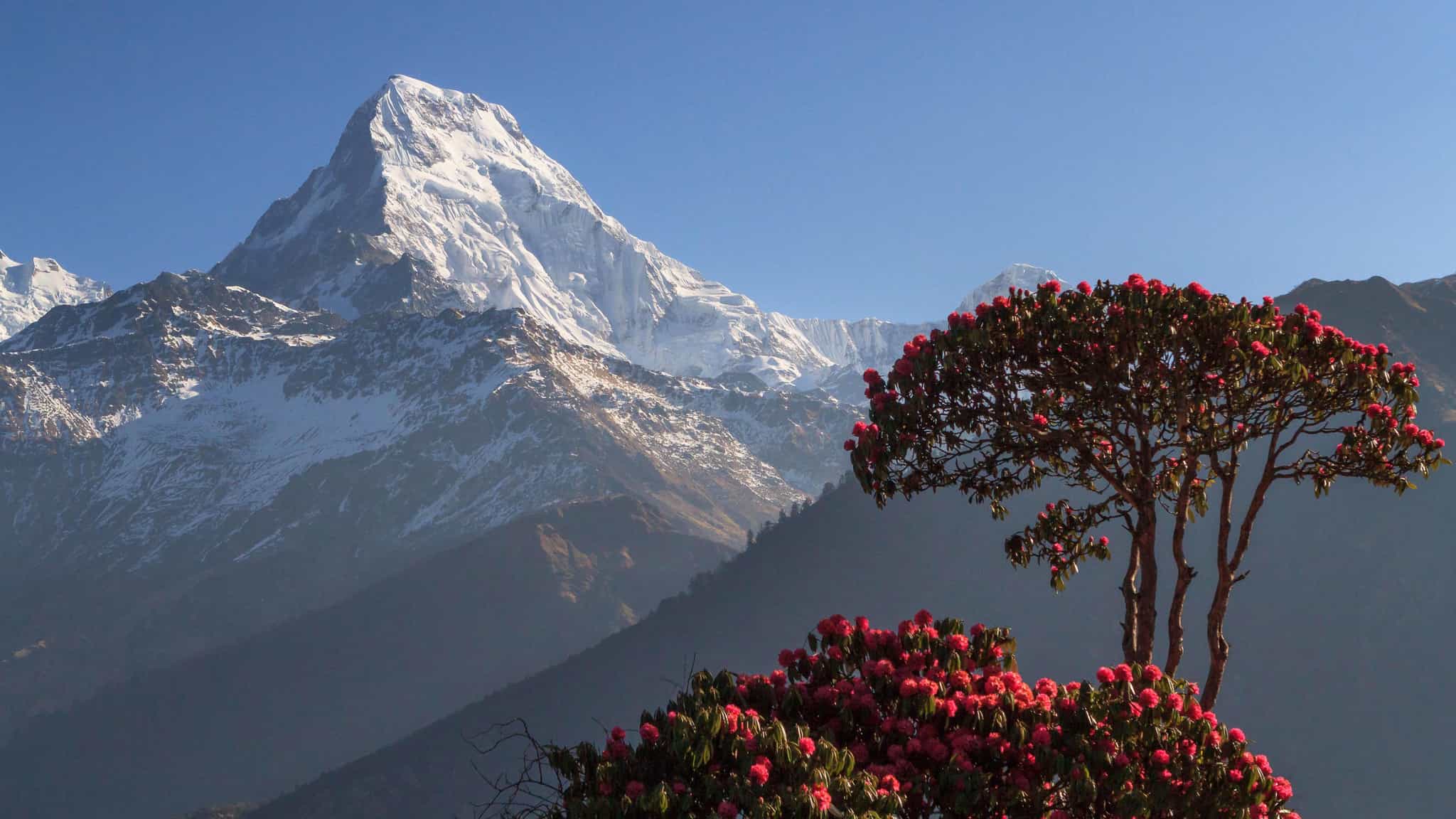
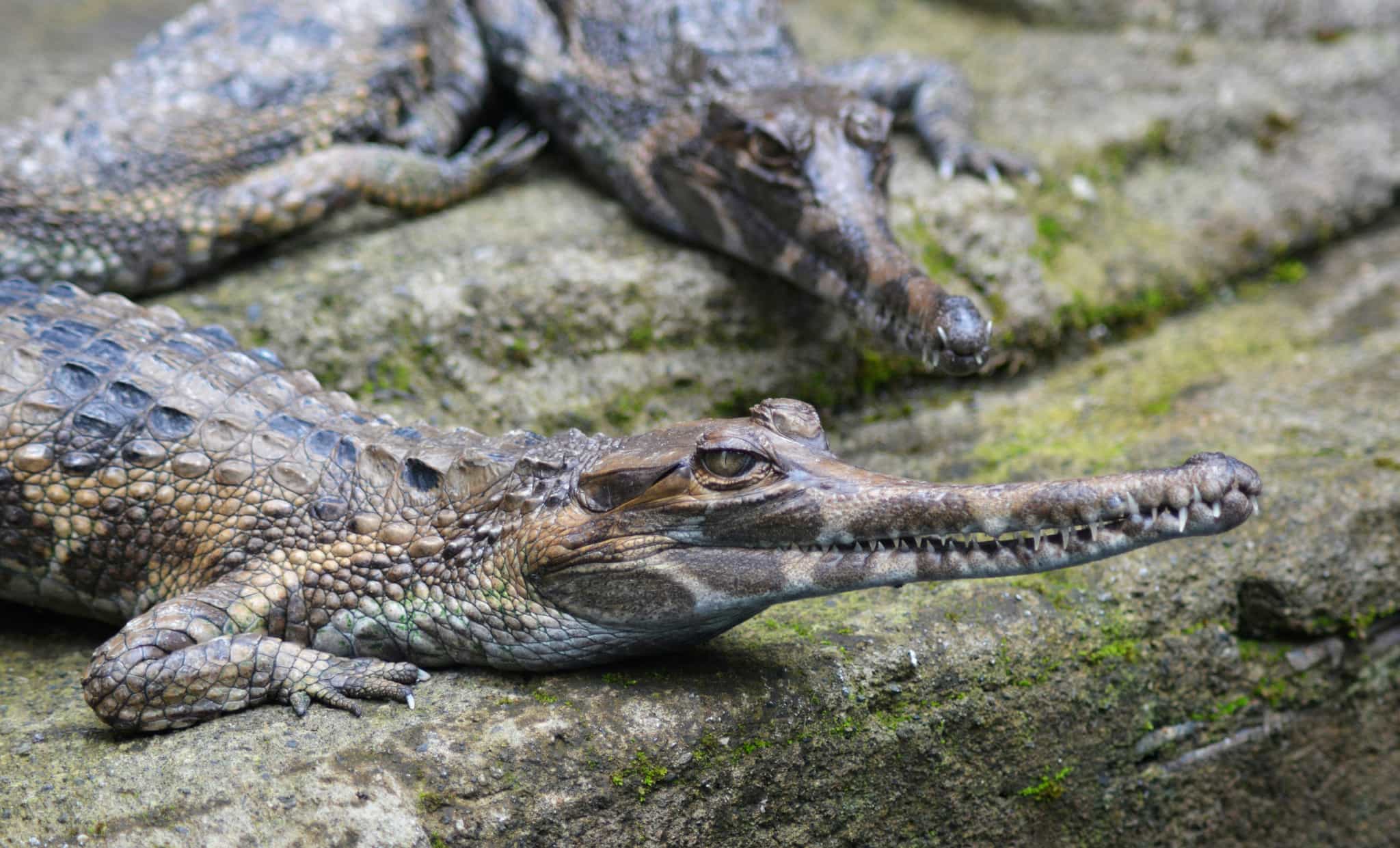
Hike among the astonishing beauty of the Himalayas, through lush forests, remote villages and towering mountain vistas
Reach Annapurna Base Camp (4130m) and come face to face with an 8,000m+ peak for views that will leave you speechless
Explore the unique jungles of Chitwan, home to one of the last remaining populations of single-horned Asiatic rhinos
This is an extended version of our bestselling Annapurna Sanctuary Route trek, allowing you to explore more of Nepal on your adventure
Key Information
Day 1
Welcome to Kathmandu
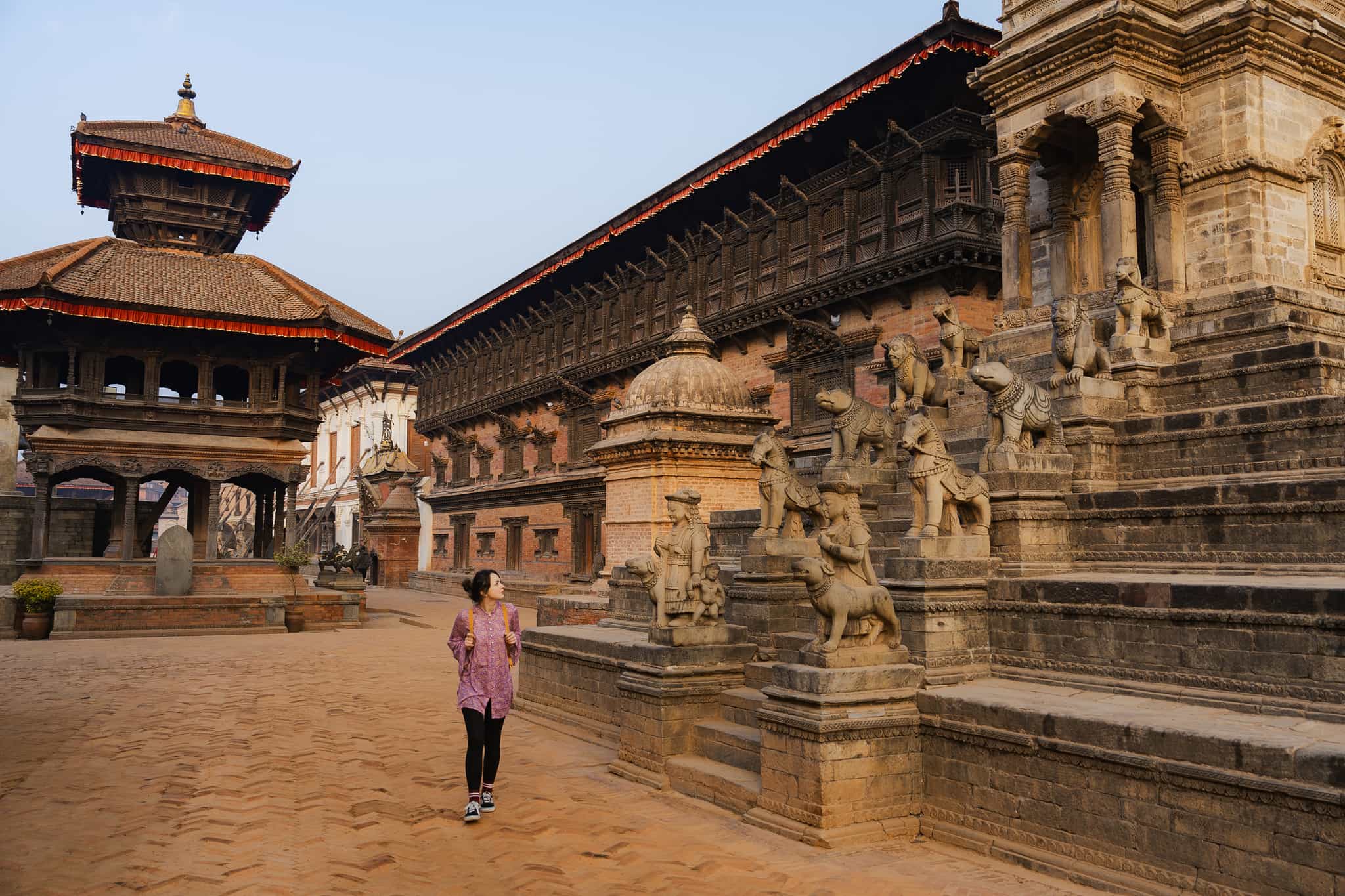
Settle into your hotel in Thamel, the lively hub of bustling Kathmandu. Once you've met up with your guides and sorted out any last-minute trek details, wrap up the day over a group dinner, getting to know your fellow adventurers.
Day 2
Road trip to Pokhara
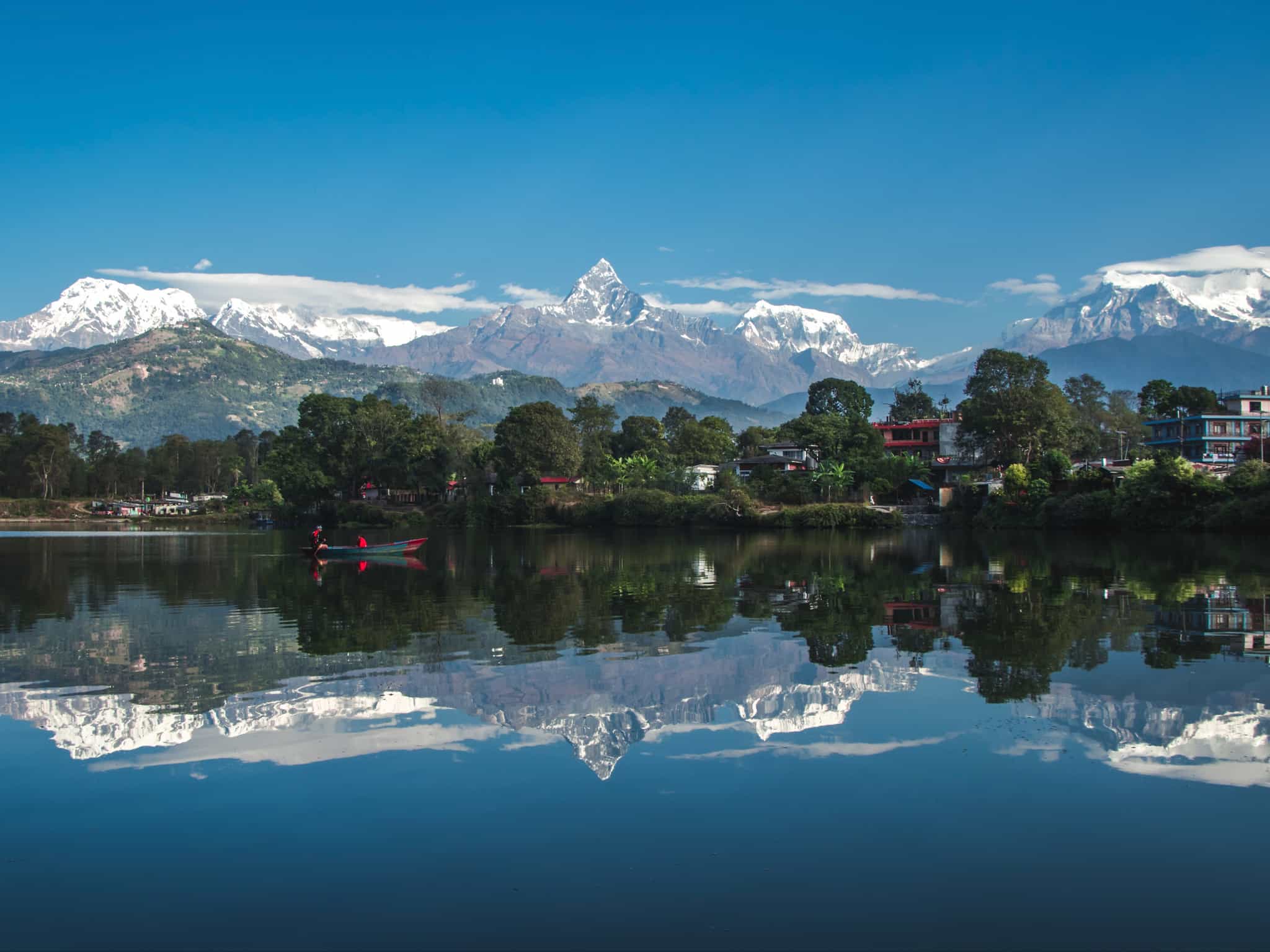
Driving
Embark on a scenic drive to the picturesque lakeside city of Pokhara (approximately eight hours away). Settle in to the drive through awe-inspiring Himalayan landscapes and terraced farmlands. On arrival, unwind at your hotel and enjoy the peaceful surroundings as you gear up for your first day of hiking tomorrow.
Day 3
The trek begins
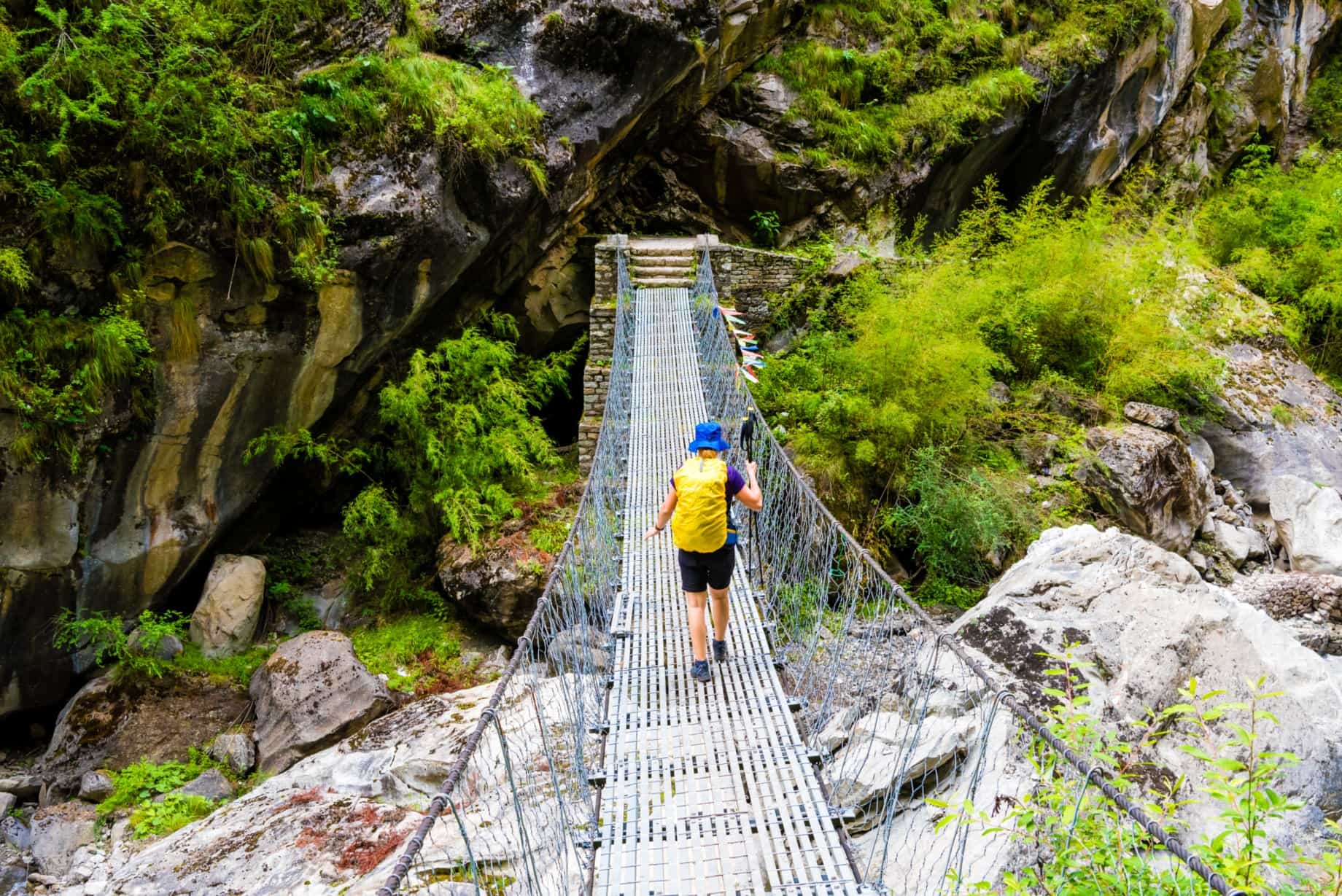
Hiking
A picturesque drive (of around two hours) will take you to Nayapul, where your trek begins. From the trailhead, step into the lush forest that gradually gives way to remote waterfalls and villages. Stop for lunch with a breathtaking view of Mount Machapuchare (6993m), then traverse a suspension bridge to start the challenging ascent up a stone staircase leading to Ulleri. While this segment may be one of the toughest on the trek, your guide will ensure a manageable pace for the group. Upon reaching the village, tuck into a hearty meal and settle in for your first night at a Nepalese teahouse.
Day 4
Ulleri to Ghorepani
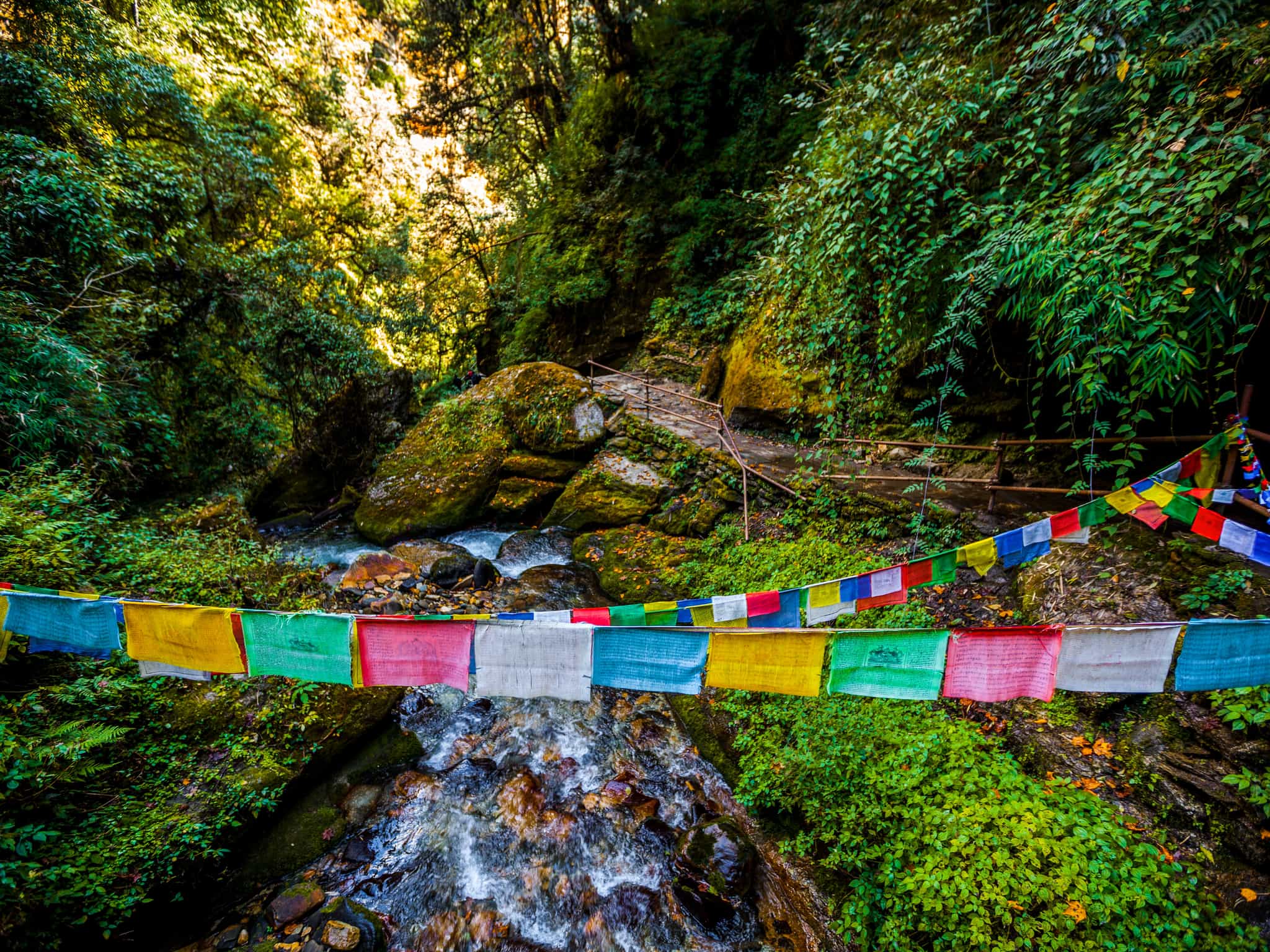
Hiking
Take in the sweeping vistas from your teahouse as you sip a steaming cup of morning coffee, gearing up for a moderate ascent through a lush forest of oak and rhododendron. If you're trekking in early spring, prepare to be dazzled by the vibrant array of wildflowers carpeting the landscape. Camera at the ready, continue directly uphill, capturing glimpses of Hiunchuli (6441m) and Annapurna South (7219m) along the way. Following another meal against the backdrop of magnificent panoramas, press onward to Ghorepani, a village that's home to the Magar community, hopefully catching a memorable sunset over the Himalayas.
Day 5
Ghorepani to Chuile
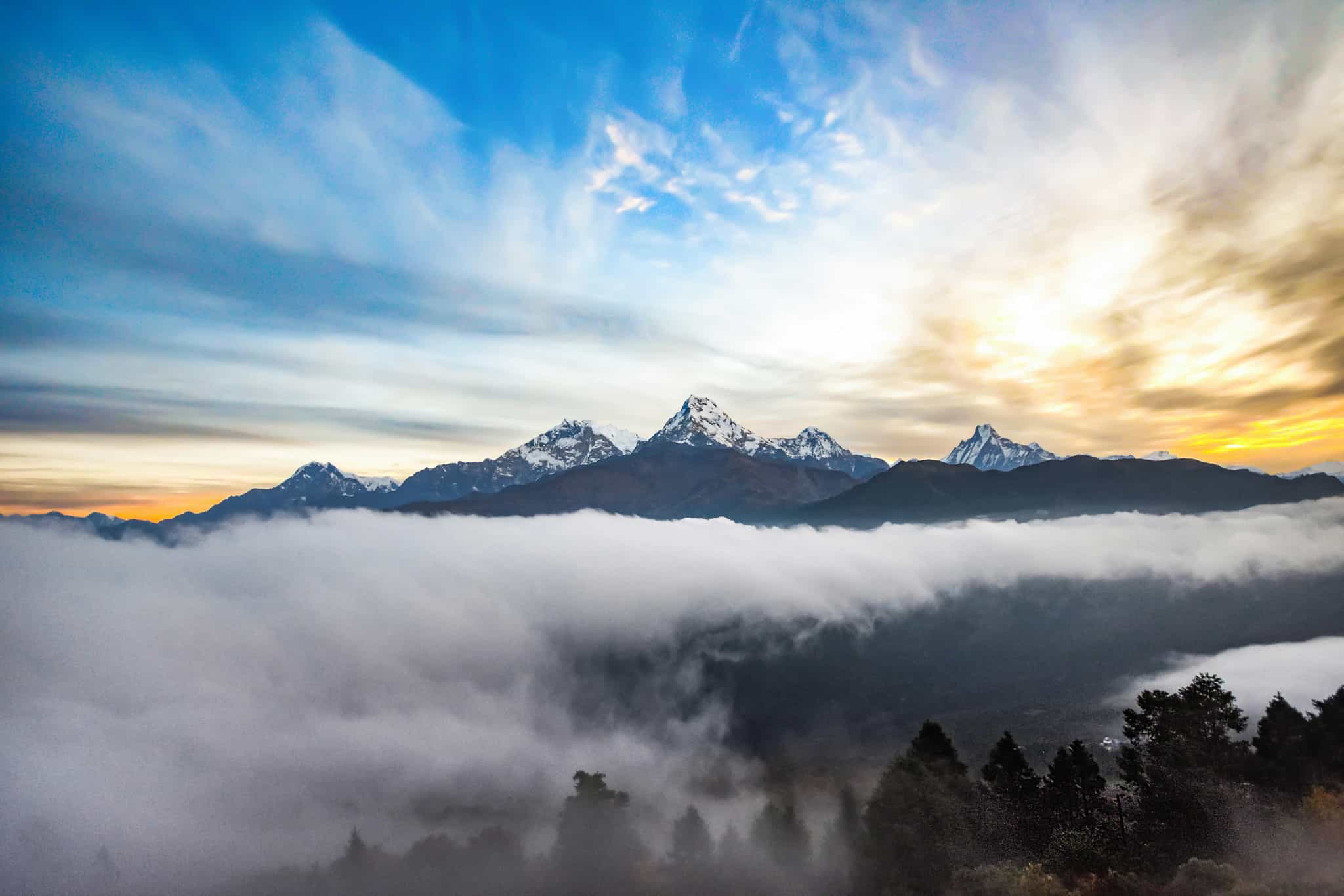
Hiking
Rise before dawn to hike towards the summit of Poon Hill (3210m), a scenic hour-long uphill trek renowned for its breathtaking mountain vistas. Arrive just in time to witness an epic and unforgettable sunrise. Afterwards, retrace your steps back to Ghorepani for a hearty breakfast before descending steeply through the rhododendron forest, navigating more stone steps to reach Deurali Pass (3210m). Take a bridge over a small stream, stopping for lunch amidst the lush greenery of the forest. Prepare for a short yet steep climb to Tadapani village, keeping an eye out for glimpses of Annapurna South and Machapuchare (AKA Fishtail Mountain). Finally, take on a gradual descent to the village of Chuile, where you'll rest tonight.
Day 6
Chuile to Sinuwa
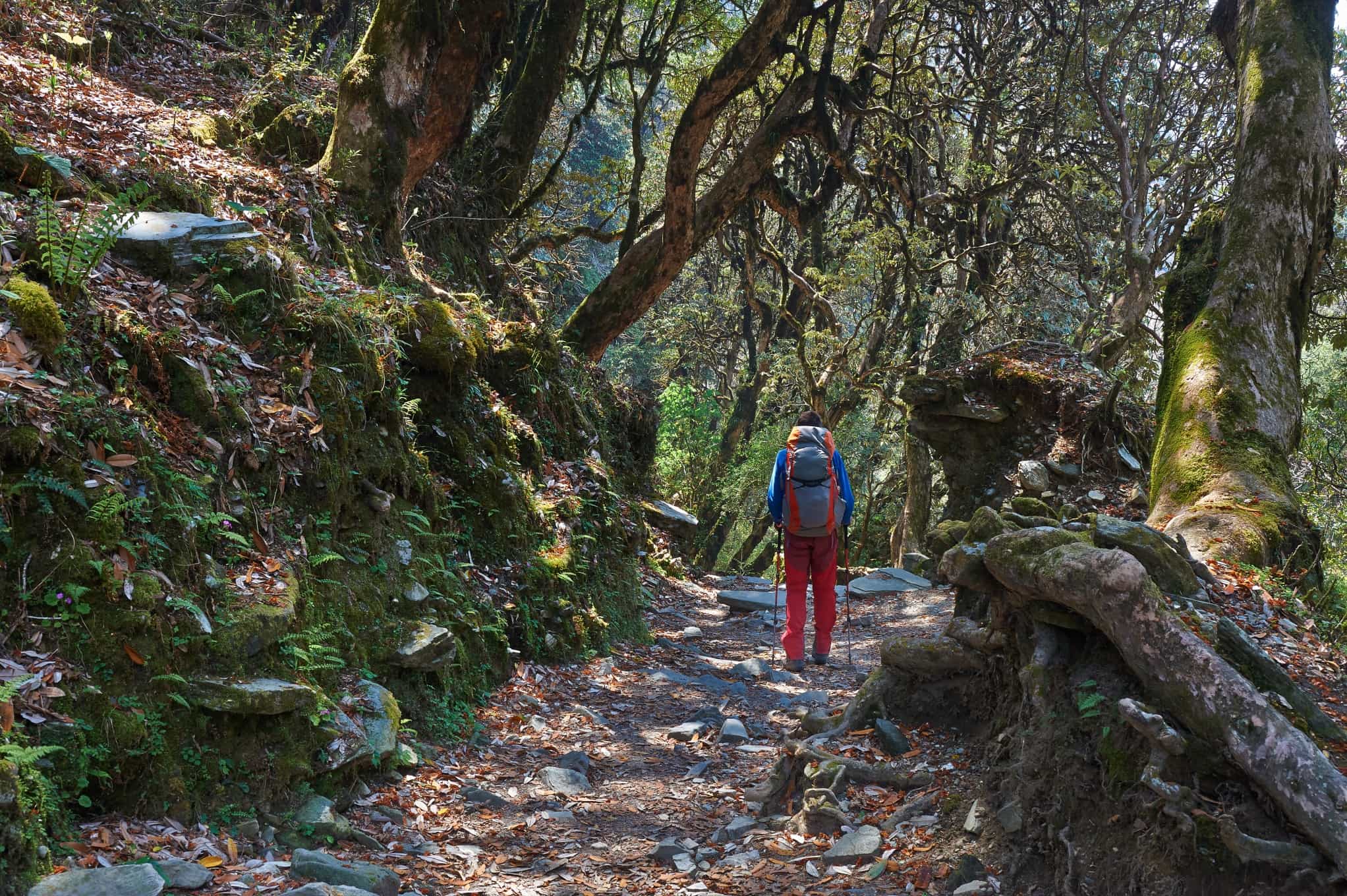
Hiking
Wake up to the stunning sight of Machapuchare peak from your teahouse, and tuck into breakfast. Begin the day's trekking by descending along the trail through sparsely populated settlements until you reach Kimrong Khola. See the landscape transform before your eyes as the forest thickens into wild, untamed jungle. Descend further to Ghurjung before facing a steep uphill climb to Chhomrong, the last permanent village in the valley. The path undulates again as you follow a stone staircase descending to the river before ascending steeply on the opposite side leading to your destination for the night, Sinuwa, offering yet another breathtaking view of the majestic Machapuchare.
Day 7
Sinuwa to Himalaya
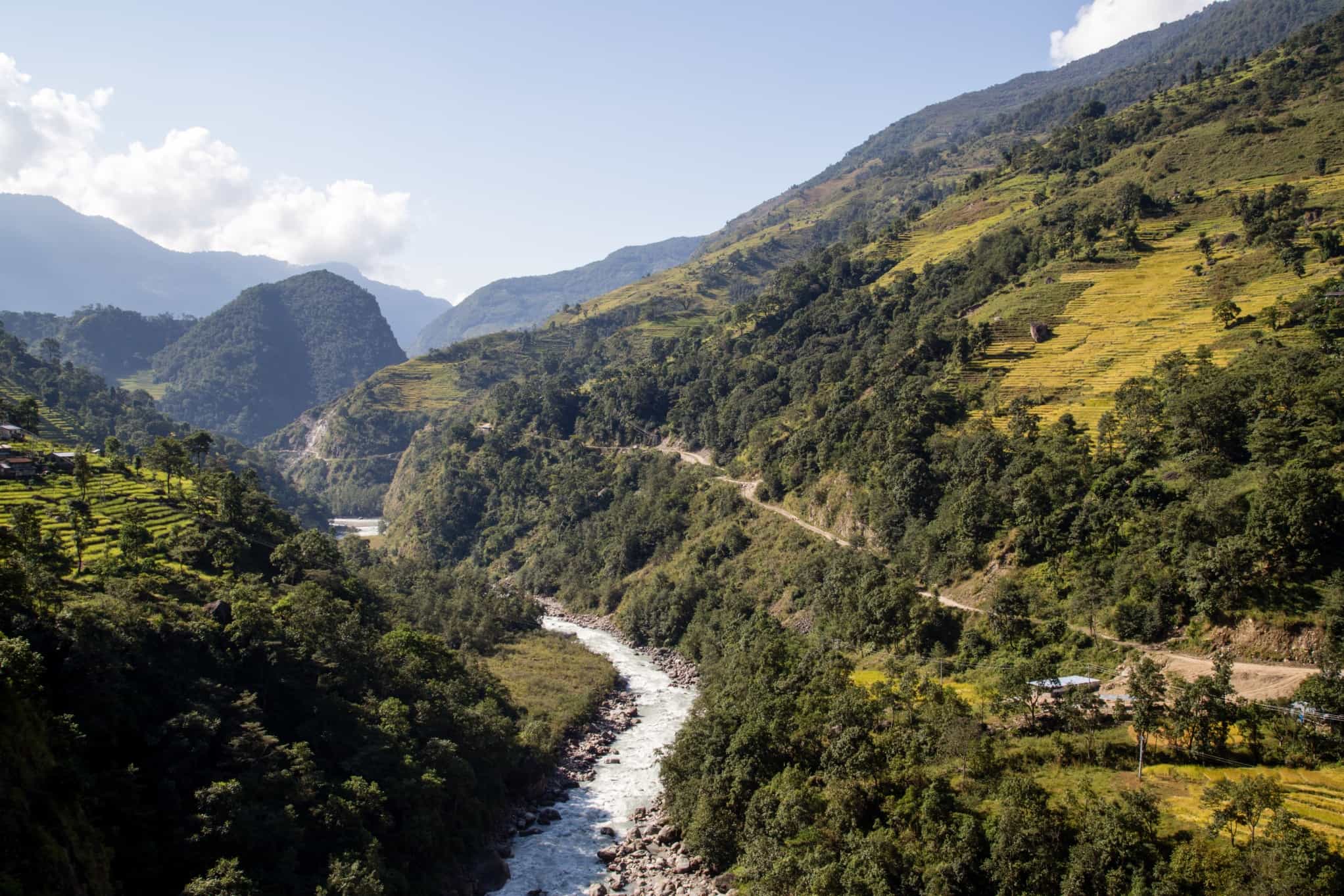
Hiking
Descend yet more stone steps amidst the dense jungle foliage. Trace an undulating path alongside a wild river as you traverse some of the most demanding terrain of the entire trek, until you arrive at the village of Bamboo. The panoramic vistas from here reward every ounce of effort, and you can take a well-deserved break before pressing on through the forest to your next destination – the aptly named village of Himalaya.
Day 8
Machapuchare Base Camp
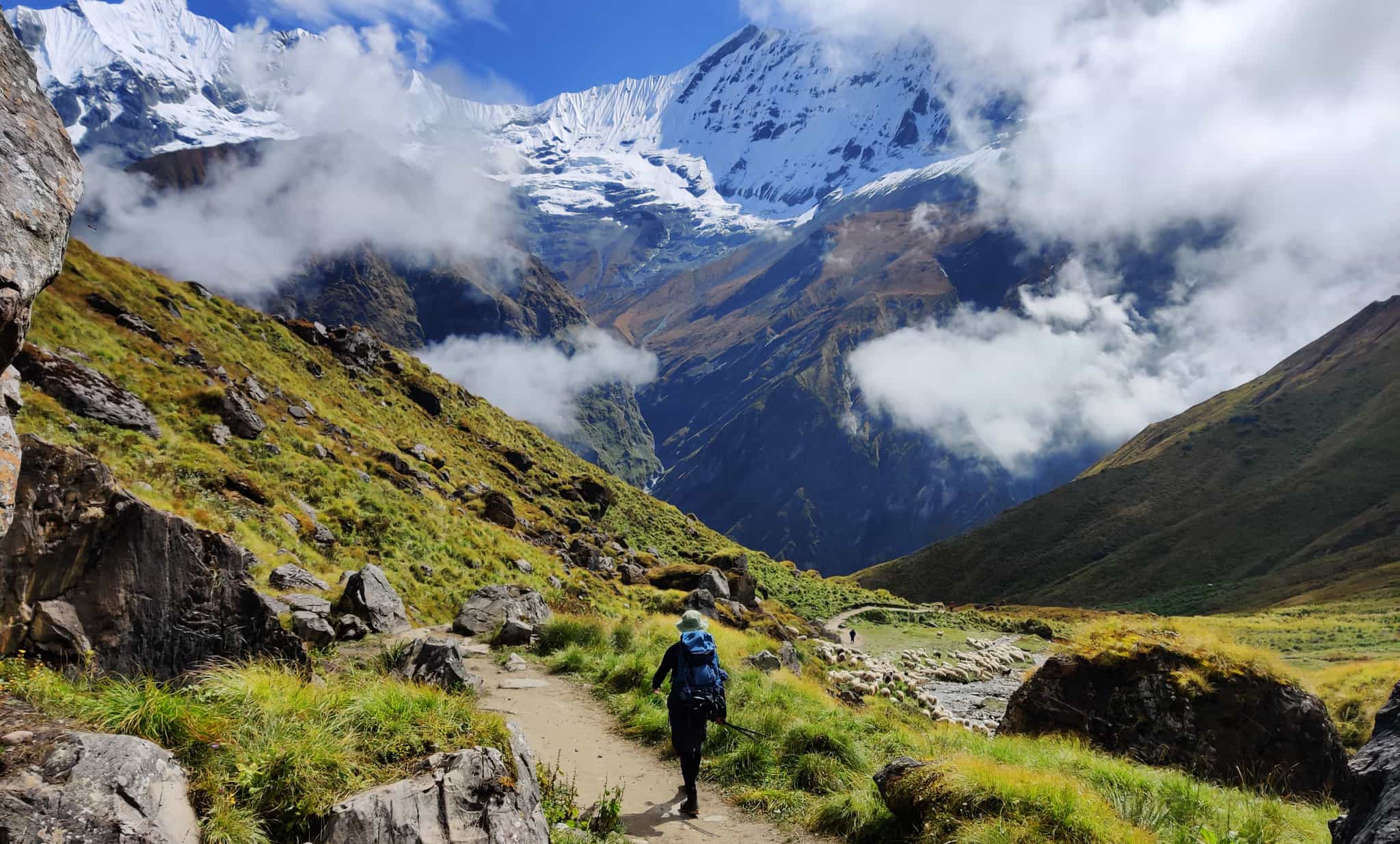
Hiking
Begin today with a challenging uphill trek through oak and bamboo forests to reach Hinku Cave, then continue onwards and upwards along a rocky trail, crossing steep ravines and several small streams via wooden bridges. As the path leads you to Deurali, you'll navigate the banks of a glacial river and ascend through birch forests, flanked by layers of snowy ridges on either side. Finally, emerge above the treeline and ascend over the mountaintop to reach Machapuchare Base Camp. Take a moment to soak in the awe-inspiring vistas, including Hiunchuli, Gandharyachuil, Gangapurna, and the magnificent Annapurna Massif. Afterward, unwind and recharge under the thousands of stars glinting in the Himalayan night sky.
Day 9
Annapurna Base Camp

Hiking
Start your day with breakfast amidst breathtaking mountain views, then bid farewell to the forests and venture into the snow-covered rocky terrain above. While the trail ascends gradually without steep inclines, you may notice the effects of altitude on your breathing and pace. Press on to complete the last leg of the journey to Annapurna Base Camp (4130m) – the pinnacle of the entire trek, which reveals why this is one of the world's most renowned trails. If the weather's good, keep your eyes out for a magical sunset in this magnificent setting.
Day 10
Annapurna Base Camp to Bamboo
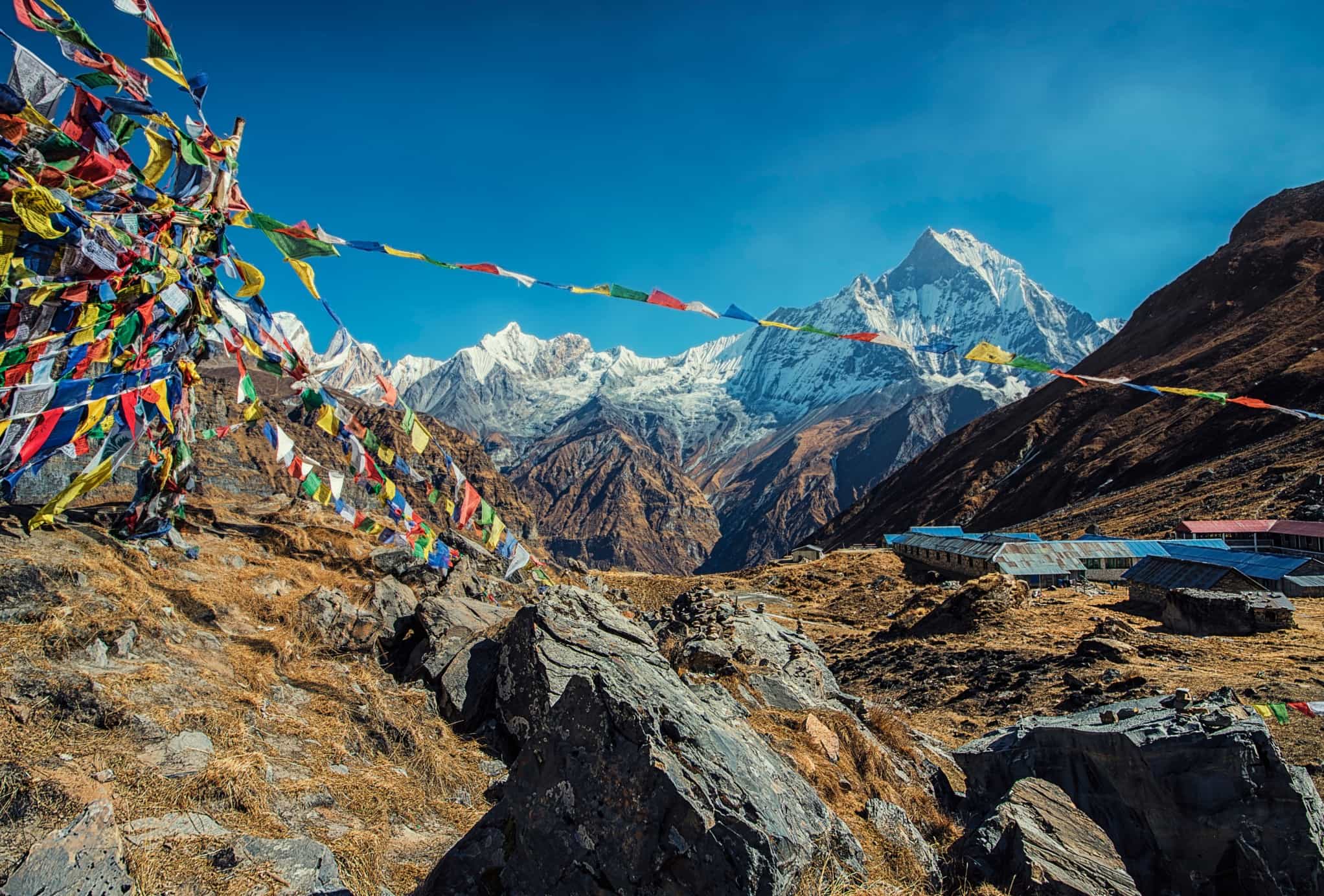
Hiking
Rise early to catch an awe-inspiring glimpse of Annapurna I, Annapurna II, Annapurna III, Annapurna South, Gangapurna, Hiunchuli, and Machapuchare as they are revealed in the peachy glow of sunrise. Get back on the trail for a downhill day, immersing yourself in the mountain vistas surrounding you from every angle. Enjoy this panoramic beauty as you gradually descend through forested slopes, culminating in a long trek to the village of Bamboo where you will spend the night.
Day 11
Last night in the mountains
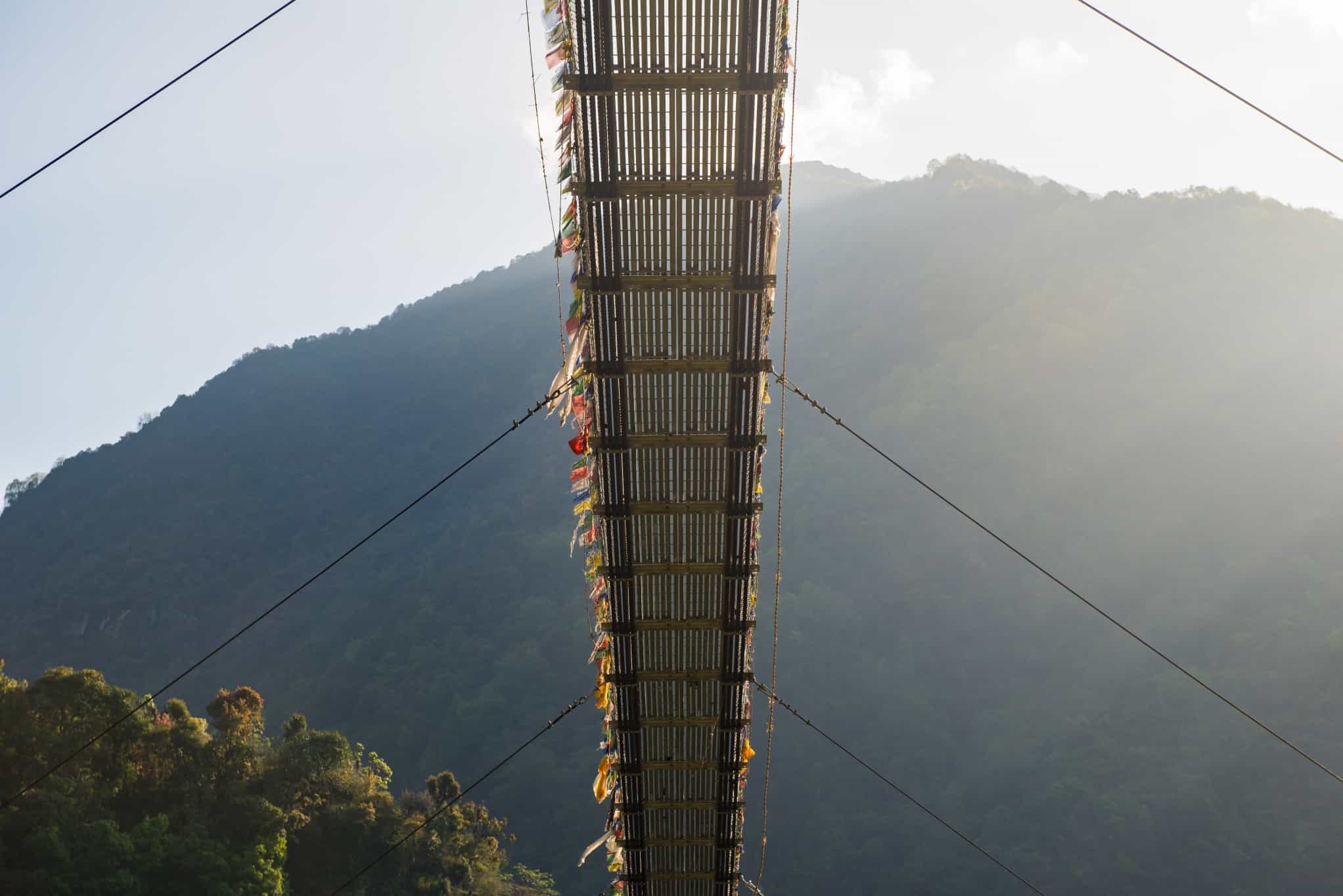
Hiking
Ascend to Khuldighar via yet more stone staircases then proceed along a gentle downhill path, navigating steps that guide you to Chomrong Khola. It's uphill again to through the village before descending to Jhinu Danda. Finally, make your way to the bubbling hot springs at Jhinu Danda for some well-deserved downtime.
Day 12
Return to Pokhara
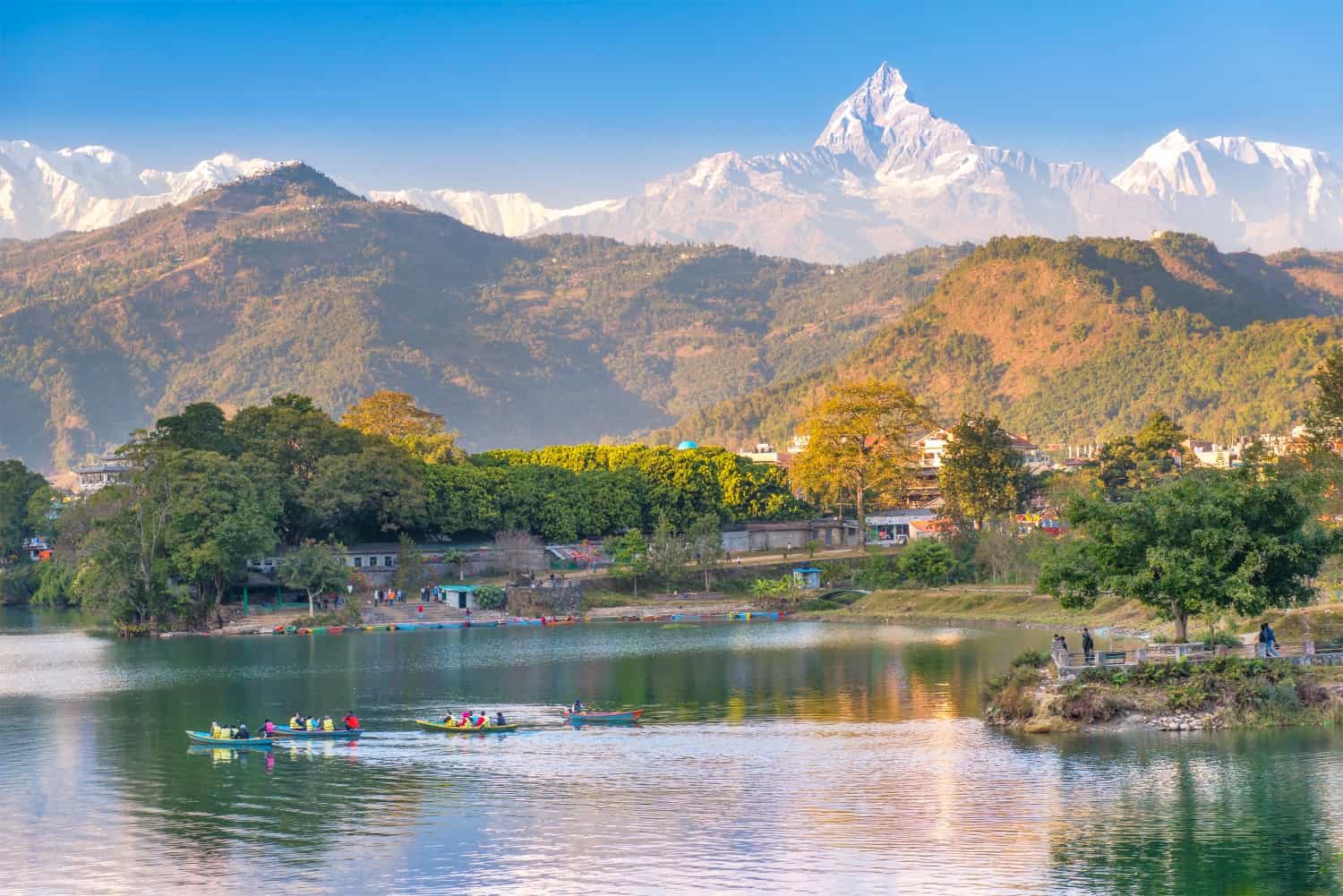
Hiking
Start your last hiking day among mesmerising views of Nepal's mid-hills. Enjoy the crisp mountain air, capture those last mountain snapshots, and savour the descent into Naya Pul, from where you'll be driven back to Pokhara. Head out for dinner to celebrate with your crew, then spend the rest of the evening relaxing, partying or catching up on some well-deserved rest!
Day 13
Hit the road to travel to Chitwan
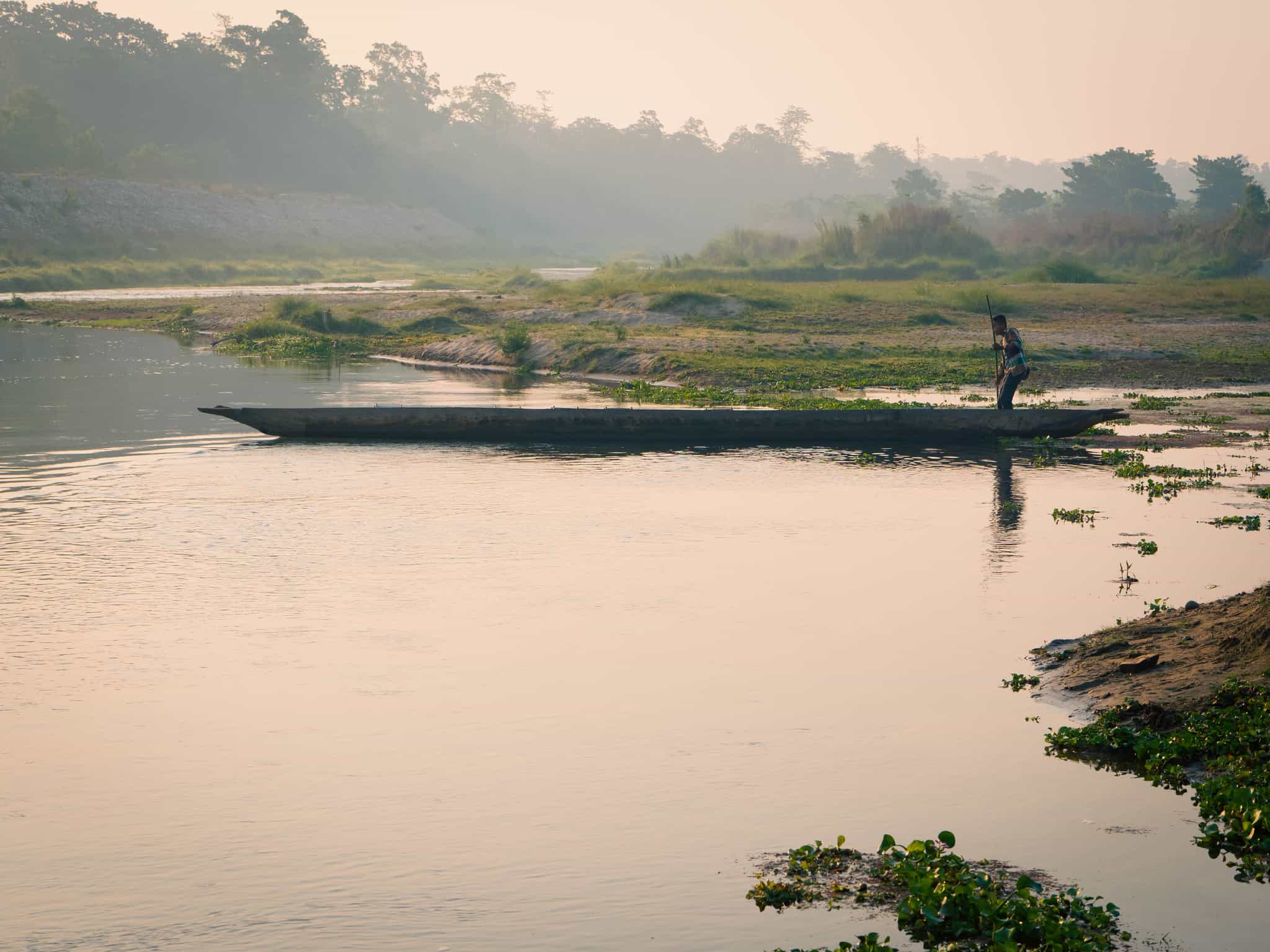
Driving
Bid farewell to the picturesque Pokhara Valley and the iconic Fishtail Mountain as you embark on a journey towards Chitwan National Park. Nepal's first national park, Chitwan protects more than 900 square kilometres of forest, grassland and an incredible array of wildlife – including gharials (crocodilian reptiles known for their long, pointed snouts), rhinos, elephants, pythons, and several species of deer, as well as the very rare and elusive big cats: Bengal tigers and leopards. On arrival, freshen up, enjoy a tasty lunch, then pay a visit to the traditional Tharu village, catching sunset along the banks of the Rapti River. Conclude this leisurely day with a tasty dinner, then bed down in your comfortable jungle hideaway before a full day of exploration tomorrow.
Day 14
Wildlife encounters in Chitwan National Park

Safari
Wake early and start your day of wildlife exploration with a visit to the Crocodile Conservation Project, an initiative dedicated to safeguarding the endangered crocodile species of Chitwan. Established in 1971, the Gharial Conservation Centre focuses on breeding and releasing these distinctive crocodiles into the wild. Next, board a dugout canoe for a leisurely cruise along the Rapti River, the perfect chance to get your first glimpse of aquatic birds, gharials, and other wildlife which feed along the picturesque riverbanks. Return to the hotel for lunch before embarking on a jeep safari through the thick, wild jungles of Chitwan, eyes peeled for local wildlife including bison and the elusive one-horned rhinoceros.
Day 15
Drive to Kathmandu
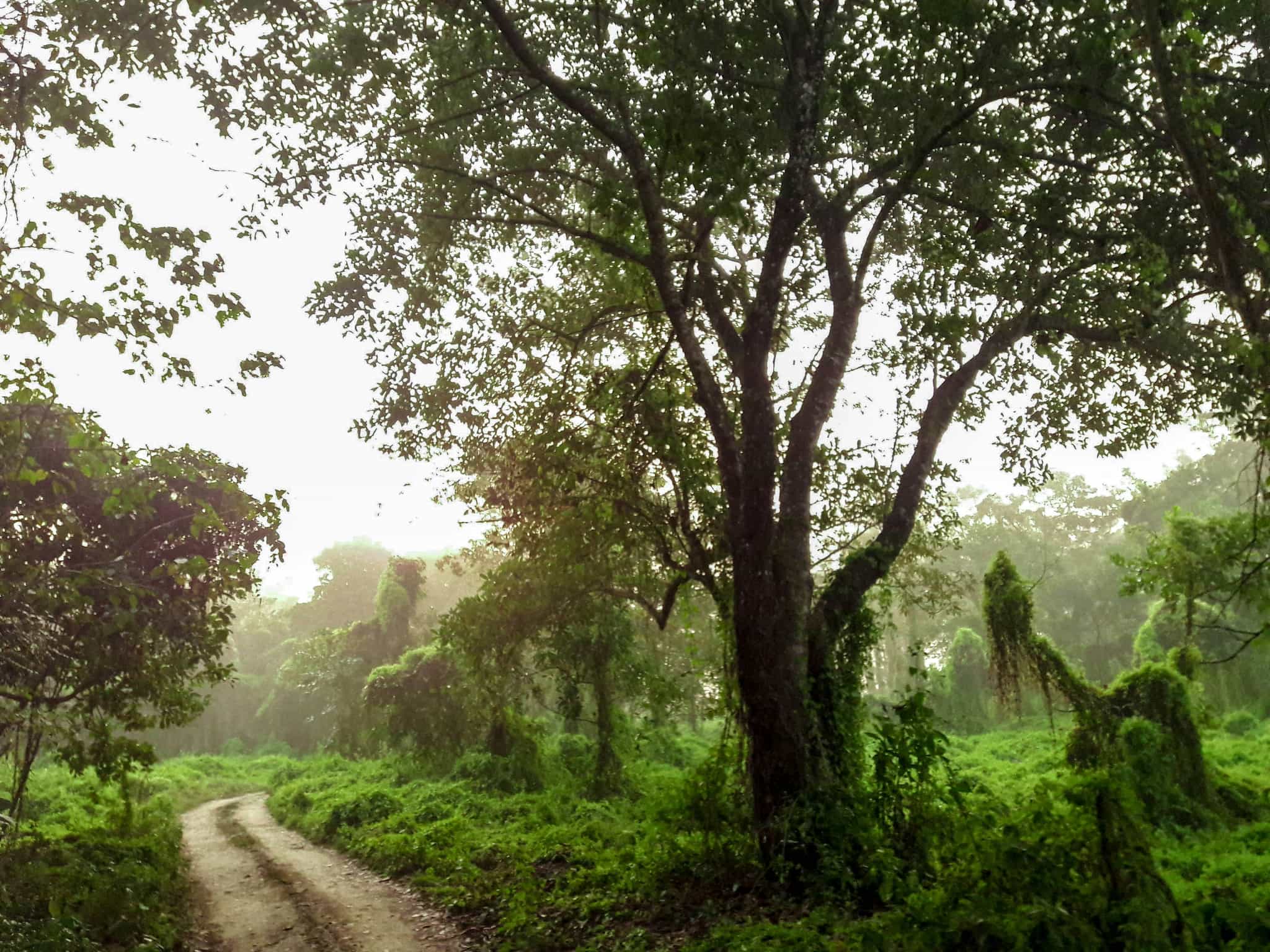
Hiking
Driving
Begin the day with an early morning jungle walk, led by a knowledgeable park naturalist. Immerse yourself in lush surroundings as you look out for diverse bird species, flora, and fauna. Later, take a bus back to Kathmandu and check in to your hotel in Thamel. Enjoy some downtime in Nepal’s capital and an optional final dinner with your team.
Day 16
Last chance to enjoy Kathmandu
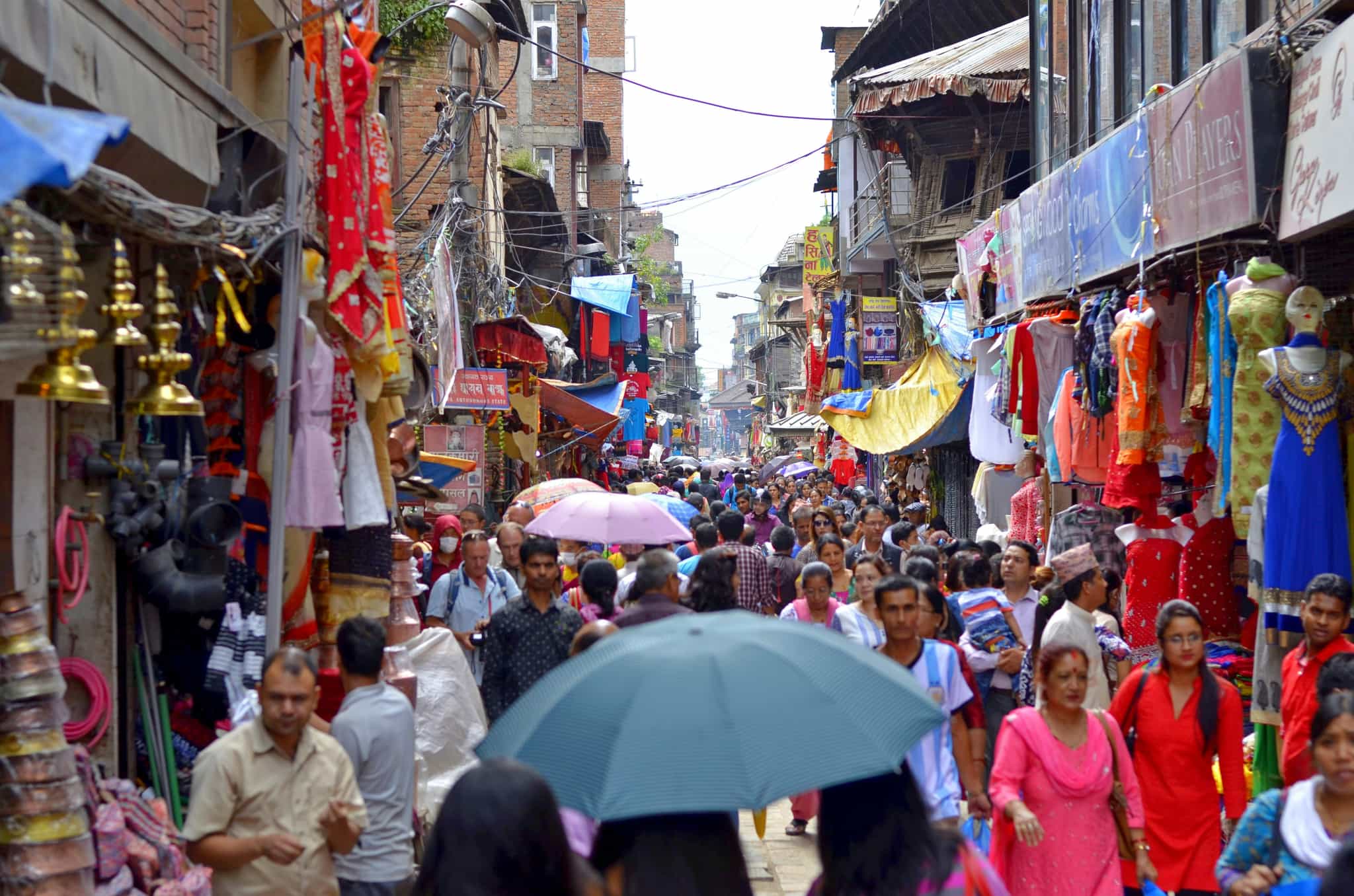
Enjoy a lie-in followed by breakfast at your hotel then, time permitting, spend your last day exploring the city before returning to the airport and back to reality.
The Area
Logistics
Starts
Tribhuvan International Airport, Kathmandu
Arrive by 16:00 on Day 1
Ends
Tribhuvan International Airport, Kathmandu
Any time on Day 16
Transfers
Airport arrival and departure transfers are included no matter when you arrive and depart (even if booking extra nights before or after the trip), provided you have completed your passenger information form and have supplied your flight details in advance. On Day 1, your tour leader will arrange a group briefing before a welcome dinner, so we strongly encourage you to book a flight landing by 16:00 in order to be able to join this on time.
Travel options
There are regular flights to Kathmandu from major airports across the UK and Europe.
Day 1
Breakfast
Lunch
Dinner
Day 2
Breakfast
Lunch
Dinner
Day 3
Breakfast
Lunch
Dinner
Day 4 – Day 11
Breakfast
Lunch
Dinner
Day 12
Breakfast
Lunch
Dinner
Day 13 – Day 14
Breakfast
Lunch
Dinner
Day 15
Breakfast
Lunch
Dinner
Day 16
Breakfast
Lunch
Dinner
What is the food like?
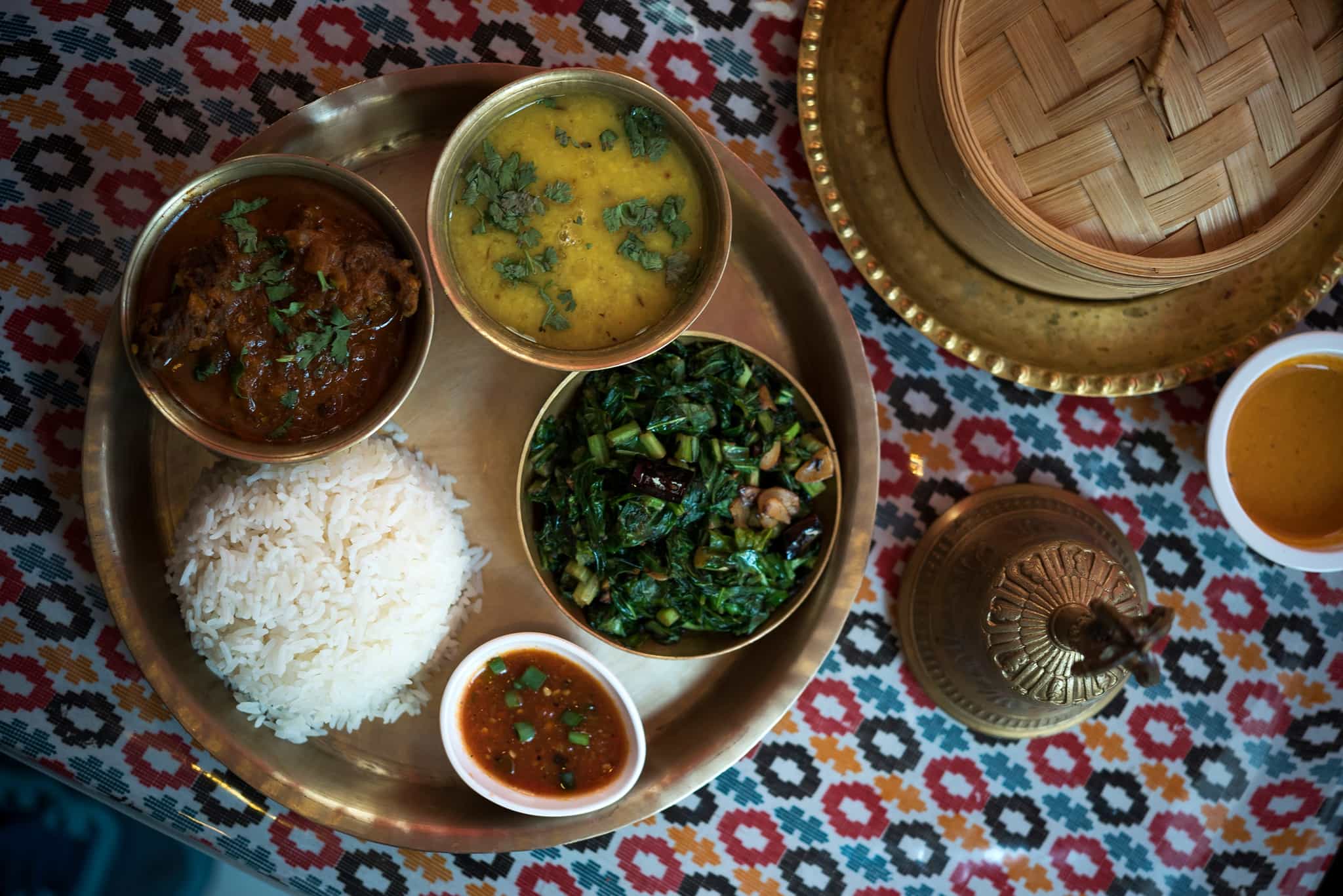
Breakfast offerings usually include hot porridge, muesli or Tibetan bread served with an omelette or boiled eggs. The dinner menus in the teahouses are very similar at every stop and there will usually be a choice of traditional Nepalese dhal bhat (a mixed plate of lentils, rice, vegetables and pickles – delicious and healthy), momos (Nepalese dumplings), mixed noodles, pasta and even pizza. Although meat is available at some teahouses, we suggest that you ask your guide for their advice regarding its consumption, as it tends to depend on how far it has travelled as to whether or not it is a safe option.
Dairy-free, vegan or vegetarian diets can be catered for while trekking, although meals may get a bit repetitive – dhal bhat will likely be your go-to staple. Gluten-free/coeliac diets are tricky to cater for on teahouse treks (beware that powdered soups and seasonings used often contain gluten, and cooking oil is commonly reused and may cause cross-contamination). Please explain your dietary requirements to your guide so that they can assist when ordering, and bringing along some extra food/snacks is advisable.
What is the accommodation like?
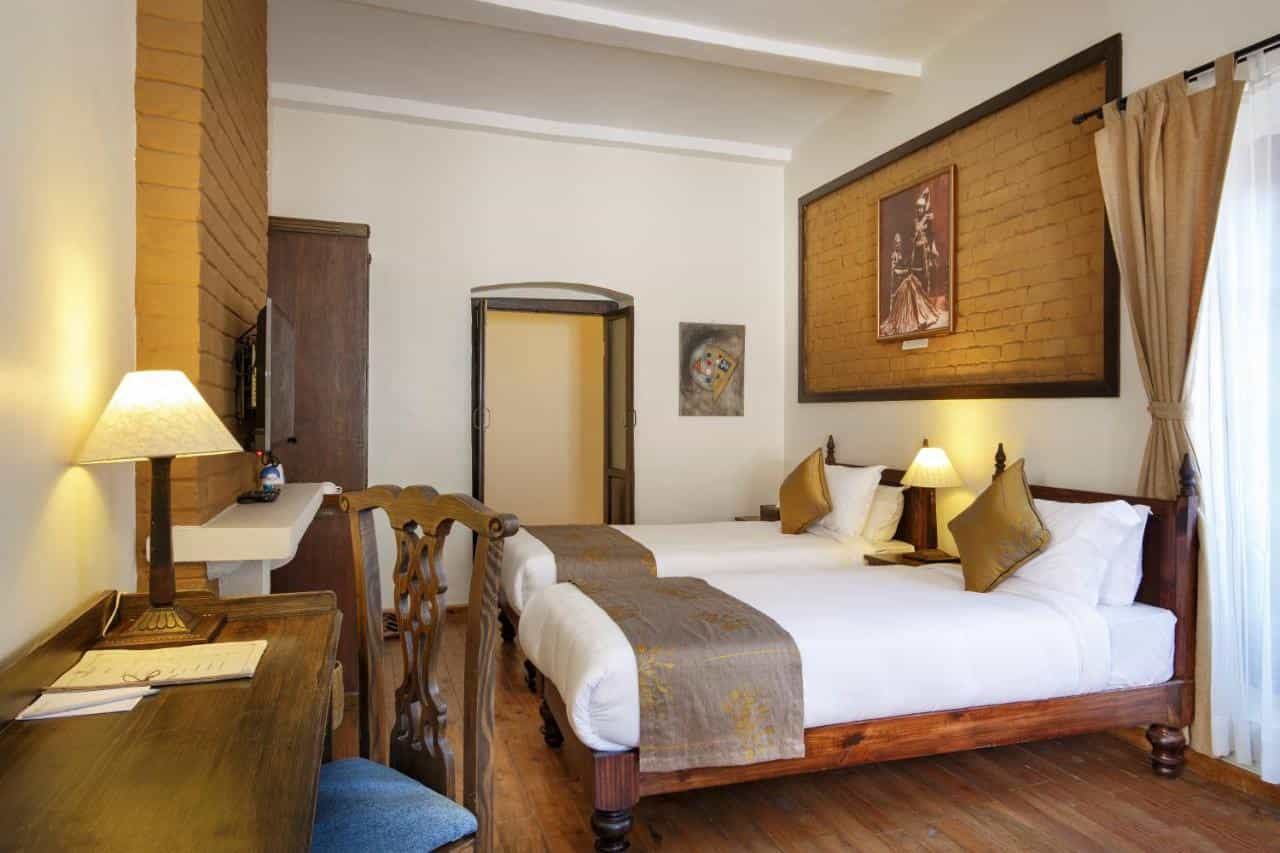
Kathmandu
On your first and last nights, you’ll stay in a centrally located hotel in Kathmandu's Thamel area on a twin-share basis, in rooms with ensuite bathrooms, air-con and WiFi. This is usually in the Hotel Holy Himalayan or Thamel Heritage Hotel.
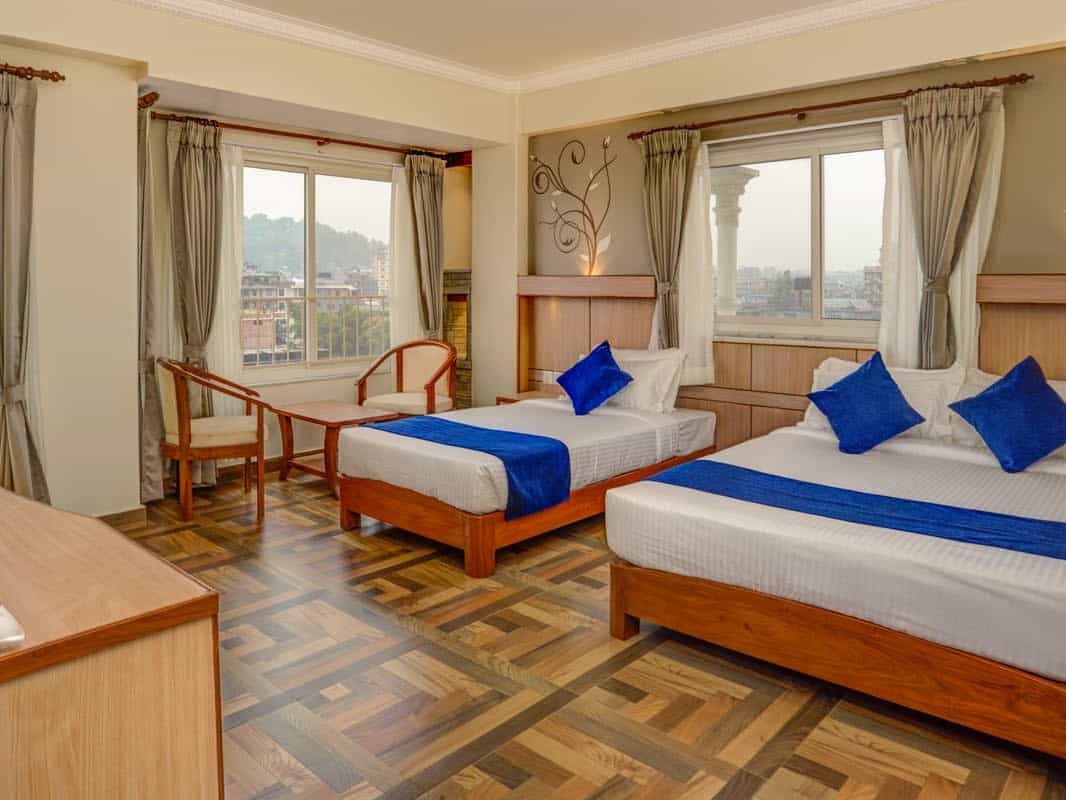
Pokhara
You'll stay in a hotel near the lake on a twin-share basis. This will usually be either the Hotel White Pearl, Hotel Big Pillow Inn or Hotel Kausion, depending on availability, all close to local bars and restaurants.
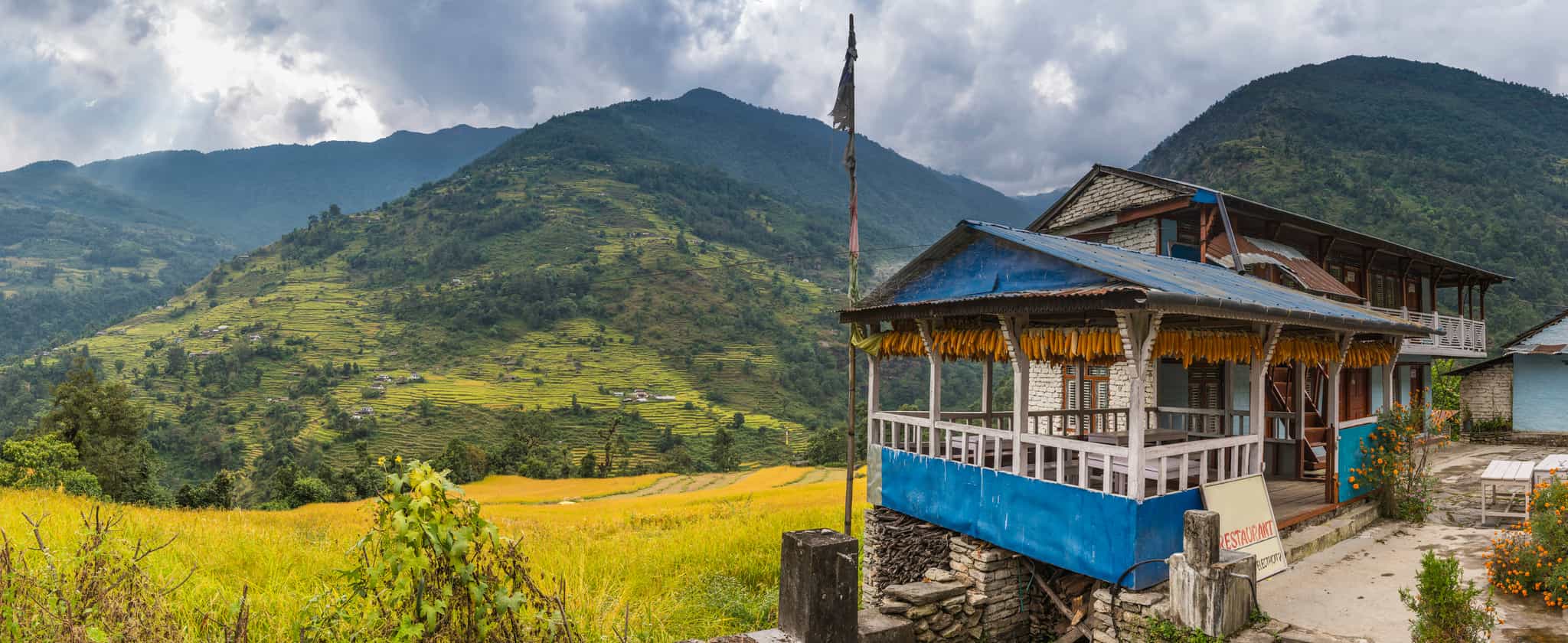
On the trail
You’ll be staying in teahouses – mountain lodges with a communal dining area and basic toilets, in twin- and triple-share rooms, usually sorted by gender. WiFi, phone charging and hot showers are often available for a small cost.
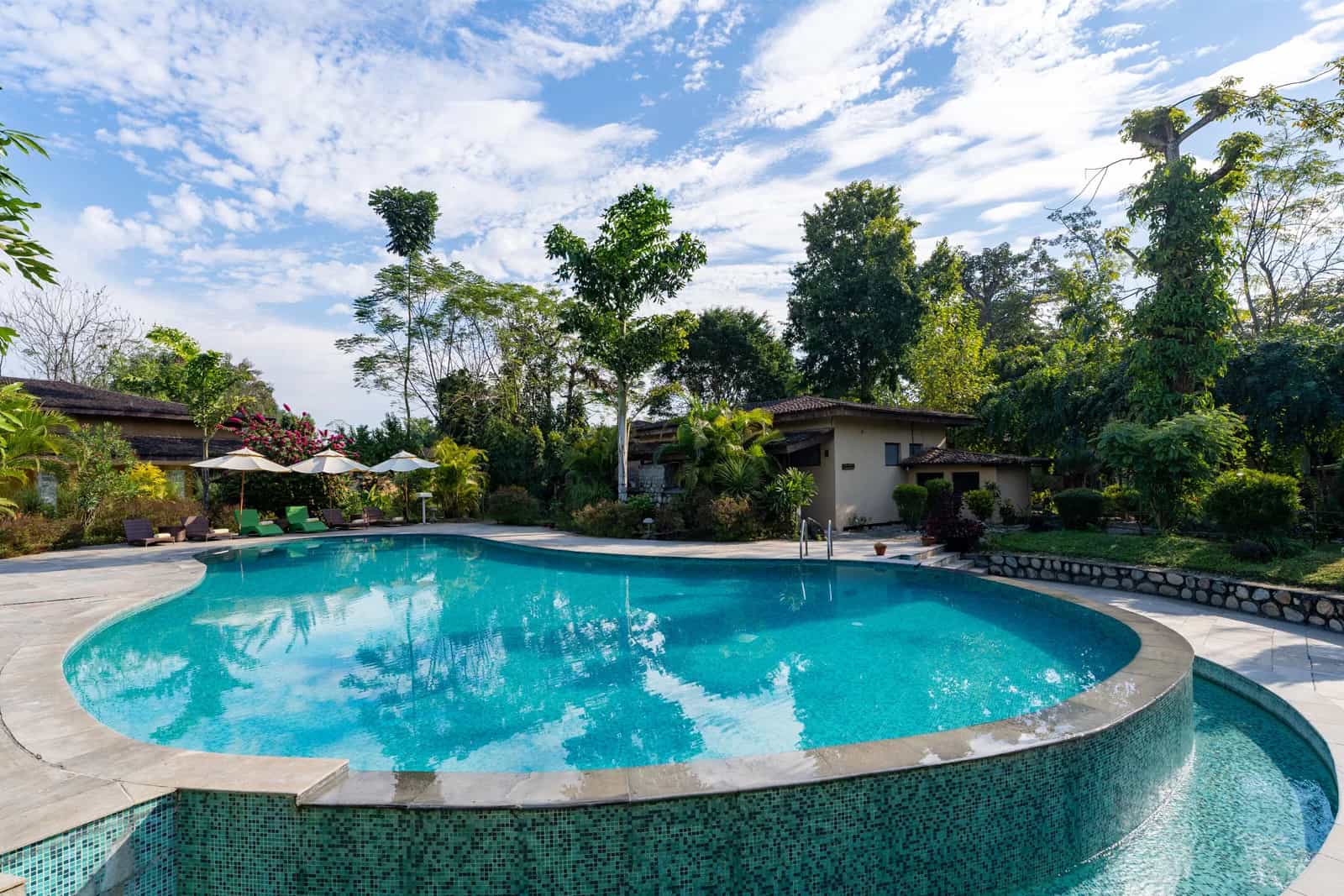
Chitwan
Your two nights in Chitwan will be spent in twin-share rooms at the comfortable Jungle Villa Resort (or alternatively, at the Jungle Wild Resort or Landmark Forest Park, subject to availability). The properties are surrounded by lush greenery and near the edge of the Rapti River.
Upgrades
For solo travellers looking for their own space, an optional private room can be booked (excluding two nights in the teahouses), subject to availability – see Optional Extras. Please request this at the time of booking.
This trip has been rated as Moderate
The Annapurna Sanctuary Route is the ideal trek for those who are keen to experience the Himalayas but aren’t quite ready for the longer, higher-altitude treks such as Everest Base Camp or the Annapurna Circuit. Ideally, you should have some experience of trekking but the trip is designed with plenty of time factored in to rest and enjoy the incredible views. Although the trek is graded as moderate, don't underestimate the effort it takes to complete: there are a lot of stone staircases on this undulating route as well as some longer days and steep steady climbs, so you may want to think twice if you suffer from bad knees.
This is one of the best routes in Nepal for acclimatisation as the ascent rate is well-paced. Still, it is important to note that trekking at altitudes above 3000m/10,000ft is more demanding on the body than walking at low elevations. Your guide will set the pace and as with all altitude treks, the theme is ‘slowly slowly’ to help your body adjust. A good level of fitness and stamina will make the going more enjoyable, so consider factoring in some training beforehand – we advise doing at least a couple of weekends of back-to-back days walking.
The days spent in Chitwan will be leisurely with short activities and walks, plus plenty of time to relax in peaceful surroundings.
What will I need to carry?
This trip includes one porter for every two trekkers. They will carry up to 20-25kg of kit so your overnight bags and spare clothes will be transported for you (maximum 12kg per person). You will only need to carry a daypack with essentials in (extra layer, snacks, water, suncream, camera etc).
The main trekking season in Nepal is from September to May (before or after the monsoon) and can be split into three seasons:
Winter (Dec-Feb): Despite being seen as ‘off-season’ this is often the best time to trek in Nepal. The nights can be very cold (down to at least -10ºC/14F) at Annapurna Base Camp but the trails are quieter and the mountain views are often at their best due to the crisp dry air and clear sunny skies.
Pre-Monsoon/Spring (Mar-May): Spring (particularly April and May) is the mildest time to trek in Nepal and magnificent rhododendron forests bloom along the Annapurna Sanctuary route at this time of year. It will be hot in the lowlands (30ºC/86F) but more comfortable as you gain elevation. Rain is not uncommon and snow cover is likely at Base Camp. Night-time temperatures should remain above freezing for the most part but can still drop below zero at Base Camp.
Post-Monsoon/Autumn (Sep-Nov): The rains can sometimes persist into September but in general this time of year is characterised by sunny, relatively mild days and clear skies. It can get cold and windy at higher altitudes and nights can be cold (typically -5ºC/23F) at the high points.
Of course, mountain weather is notoriously hard to predict and snow and extremes of temperature can be expected on any trip so come prepared.
Chitwan sits amidst the sub-tropical lowlands of Nepal and you may encounter temperatures above 30°C and high humidity.
A trip to remember
An outstanding trip I stumbled upon by chance. I had always wanted to trek the Himalayas and could recommend doing it this way enough. Having local guides makes everything easier but I couldn’t speak highly enough about ours. Sabin and Pravin were what made the tour amazing. Their knowledge, leadership and ability to create such a close group so quickly were outstanding. There to help at any moment and really going above and beyond and quickly felt like two friends more than anything. An additional shout out to our porters who were great and always there to help - and hold up for us if we needed something, incredibly dynamic to account for us
Incredible views, amazing team
Such an incredible trip. Our guide Sabin could not have been better, he and his team took such great care of us, everything felt seamless. The views were unreal, the hike well-paced and I was really impressed by how all of our different needs were catered for. Despite being challenging in parts (so many stone steps!), the trip is well-designed so nothing felt unmanageable and being in a group with such a great sense of humour helped too. Would be amiss to not mention how legendary the porters are, forever in awe. The safari at the end was a perfect finisher and was very happy to have seen a wild elephant less than an hour after arriving at our hotel! Nepal is a beautiful country and I can’t wait to come back for the next one.
This was one of the
This was one of the best trips that I have taken. The trek was challenging for me. The staff made it possible for me to complete the trek and enjoy the journey. The trek leader and the assistant leader " Sabin & Pravid " went above and beyond to ensure that every person on the trek got the most enjoyable trek possible.
Such a well planned trip!
Nepal has been a bucket list trip for quite some time and I really appreciated how thorough MBA’s itinerary was - especially including the safari after trekking! It’s a beautiful country but Kush, our amazing guide, and MingMa and Santos, our incredible co-guides, made it so seamless and memorable! We loved getting history lessons about Nepal each night, the thoughtful breaks in the day and top notch organization of all of our stays, plus just the jolly energy while we hiked/took buses/explored all of the places in between. And a special thank you for the thoughtful birthday celebration - it made me feel very looked after! I highly recommend the trek & safari trip, and look forward to booking another adventure soon!


Wow. Amazing. An experience worth more than money can buy
Much Better Adventures and Freedom Adventures have crafted this experience into a truly special and life-changing experience filled with adventure, good people and culture.
The journey up to Annapurna basecamp was planned to perfection, with manageable distances, plenty of rest stops, wonderful food and every opportunity for restorative tea. Make no mistake - you will be heading into the mountains so there is a lot of up - but bring walking poles, good boots and your body will adapt quickly. The guides make sure that everyone is gradually adjusted to the altitude and monitor everyone careful for any signs of altitude sickness - of which we felt very little! The variety of scenery on the sanctuary trek was truly the best part and I felt very happy to have chosen this route.
Accomodation is amazing - with the best hot food, comfortable beds and wonderful people throughout - considering how high up these places are, I was very impressed - you rarely get this on mountainous multi day treks.
One of my favourite features of this trip close to my heart were the stories all the guides told, about the history of Nepal, everything from its leaders, variety of culture, religion and fascinating history - we were blessed with the most wonderful guides Kush, Minima, Santosh and the superhuman supporters Khusiman, Suman, Jivan, Hari, Bical and Ashish.
Chitwan was a magical experience - a very different environment to the mountainous region of Nepal, but filled with its own magic in the form of beautiful jungle, rivers and forests full of so much life. Our guides were incredibly knowledgeable about the life present and pointed out all manner of birds, crocodiles, ungulates and the infamous Rhino of course! A wonderful relaxing few days of luxury following the trek. The beauty was not in isolation, we were educated about the area, the indigenous people and community living around and the natural history that makes this national park so important to Nepal.
Kathmandu is very warm in the winter (November time) compared to the UK, and a lot of the trek at this time was quite warm especially with the steep-up sections. So make sure to pack lighter clothing in November to use for Kathmandu/Pokhra and you can leave this at the hotel to come back to clean clothes. I had brought more long sleeves and thicker trousers coming from a UK November - don’t make the same mistake, but you can buy loose linen clothing in the shops just outside the hotel very cheap. You can also do laundry at the cities for very cheap before heading to Chitwan.

An incredible trip!
We had the most amazing time hiking to Annapurna Basecamp and would definitely recommend doing the additional days in Chitwan. The trip was probably the best holiday I have ever had. Everything was throughly thought out by Kush and his team and they really went out of their way to ensure we were having the best time.
A special thank you to the whole team who without each individual I’m sure the whole experience would not have been the same! And if you’re thinking of booking then do it you won’t regret it!
Thank you for carrying our bags and for all the smiles and laughs: Khusiman, Suman, Jivan, Hari, Bical and Ashish.
Thank you Kush, Mingma and Santosh for showing us the way!!
Thank you!!
Looking like a wow
This is such a well curated trip.
Unsure what option to go for from the plethora of trekking options in Nepal, I landed upon this one. Keen to also visit Chitwan, I was hesitant to book them in a combined trip fearing one experience would be the focus and the other a rushed add-on.
I needn't have worried. The schedule is so well thought out from the initial get together meal to meet the group, to the shorter final stint up to ABC allowing plenty of time to savour views. I also appreciated that at no point it felt rushed, we got time to explore Pokhara and plenty of time to relax at the incredible resort in Chitwan.
Of course, every trip like this needs a guide and we had a special one. In Kush, ably assistant by Mingma and Santosh, I could not imagine a better leader for our group. He was knowledgeable, regaling us with stories of Nepal of an evening and answering our many questions during the trek; hilarious, complete with many quotable catchphrases; and reassuring, we always felt safe in his hands. Mingma and Santosh were superb support guides, and fantastic company throughout the trek.
Our porters, Khusiman, Suman, Jivan, Hari, Bical and Ashish ably carried our bags from teahouse to teahouse. I really enjoyed that they got involved of an evening with our many games and at the farewell dinner, they were awesome company! It was lovely to get the opportunity to thank them for their work.
To summarise the trek: there were a lot of steps, up and down, not too much flat ground! The teahouses were much better than I had anticipated, we were always accommodated in the best way possible (I got a room to myself most nights). The food at the teahouses was superb, especially the dal bhats :)
To summarise the safari: The accommodation was amazing and included a pool! It was a fantastic detox from the himalayas. Food again was really good and served buffet style. As for the animals, we saw 7 rhinos, crocs, deer and an extraordinary number of bird species. The guides at the resort really knew their stuff, I enjoyed the debate about the marabou stork :)
The trip was made by the fantastic group of people I shared it with, we clicked instantly, and thoroughly enjoyed our 2 weeks together. . . this seems like a good indicator for future MBA trips!
Brilliant Trip!
Really good trip and really enjoyed the whole package. Chitwan was a brilliant addition to the trip. Very relaxing end to the trip and enjoyable schedule. Kush was amazing all the trip. Perfect level of comedy and education, really appreciated it. All the assistant guides Mingma and Santosh were fantastic and level of service was amazing. The support staff did a fantastic job and thanks for joining in our evening games! Already recommending to my friends.
Great adventure!
We had an amazing trip to Annapurna, full of beautiful scenery, people and dogs. Going to Chitwan was a great to wind down and see something completely different. Thank you to the support staff Khusiman, Suman, Jivan, Hari, Bical and Ashish. Our assistant guides Mingma and Santosh were also very attentive. Thank you Kush for being the best and funniest guide ever. Can’t wait for the next much better adventure!
Momo-ments to remember! 🥟
This was our first experience of multi-day trekking with a group, guides and support staff, and what an amazing way to begin.
On a practical level, having our lead guide Kush, and assistant guides Mingma and Santosh, handle all of the logistics, navigating and decisions, really allowed us and our group to enjoy the trekking. However, good guides do a lot more than just this - Kush's energy, constant joking and encouragement kept our spirits up throughout, and made the trek so enjoyable.
We particularly enjoyed the evening talks about Nepal, as well as seeing the next generation of guide leaders being given opportunities, including our female guide Mingma. Mingma and Santosh both showed great patience and capability with looking after all of us as a group of individuals through the mountains. The positive attitude wasn't just with our guides, the wonderful support staff (shout out to Khusiman, Suman, Jivan, Hari, Bical, Ashish) also shared laughs and games with us sometimes in the evenings. Our final dinner altogether really showed us who the best dancers were (not us!)
We loved the sound of the itinerary when we booked. In our experience, the trek was paced really well, with shorter/longer days to allow rest and opportunities to see sunrise views, photo spots etc. It also gave a real sense of achievement reaching ABC after some challenging days. The two days at the end spent at Chitwan were a joy, and our stay, relaxing by the river and venturing into the national park to see rare animals, could easily have been extended by another day. It was the perfect end and change of pace.
We felt really lucky to have had such a like-minded and fun group of individuals with us. We didn't expect this to be a big part of our experience, but the laughs, games and conversations shared were easily a top highlight. We saw larger groups and private solo/couple travellers, but wouldn't hesitate to recommend booking onto this trip as MBA attracts great people and runs good sized trips. We had a mix of couples, solo travellers and a family, which worked really nicely.
During the trek, nights were cold and everyone had their ups and downs at points. That said, there were more comforts available to us than we expected (WiFi, showers, familiar menu items) but the Nepalese food was truly delicious and the best for filling up after a long day of trekking!
This was a big trip for us that we have been thinking about for a while, and it surpassed all our expectations. We've made new friends and lifelong memories. Don't hesitate to book this trip and visit this amazing country.
A trip to remember!
The Annapurna Sanctuary trek was perfectly paced and stunning at every turn, we were really lucky with the weather and I especially appreciated that the day we arrived at ABC our walk was actually quite short, which allowed us to really soak in the views and take hundreds of photos. I cannot imagine a more wonderful leader than our lead guide Kush on our trek, it was clear he always had our safety and wellness prioritised, but he fostered an environment that was motivating and full of camaraderie and hilarity. Our whole group loved his energy and especially looked forward to his talks about Nepal in the evening, which we felt were really special in helping us understand Nepalese history and culture better. There were moments it was clear Kush really went the extra mile for us and it was hugely appreciated. Mingma and Santosh were fantastic assistant guides, they were both so attentive and especially patient with our hundreds of questions whilst trekking! They were so integral to our group dynamics and it was lovely having such kind and approachable guides with us, especially in the evenings during heated games of Yahtzee! Of course another special mention to our wonderful support staff (Khusiman, Suman, Jivan, Hari, Bical, and Ashish), who we were in constant awe of for carrying our bags along the trek. It was a real highlight being able to share a meal with them all at the end of our trek, especially the dancing we all got involved in!
Ending our trek with a trip to Chitwan was absolutely lush (almost making the sub zero temps at ABC a distant memory!) Every staff member at the resort was incredibly knowledgable and attentive to our needs, even in our down time they were happy to answer our questions and alert us to animal sightings from our seats! It was a really lovely change of pace from the trek and the safari (dug out canoes on the river and jeeps) was amazing, we were really lucky to see seven rhinos, as well as plenty of crocs, monkeys and birds. It was great being able to see a completely different (flat!) part of Nepal after being in the mountains.
I cannot say enough good things about this trip, every detail seems to be well thought through and as a solo traveller, I felt really well cared for from the moment I booked it. Our group got on so well and made so many lovely memories. If you’re thinking of booking, just do it!
Great team made tough trek fun
Kush was amaaazing, very knowledgeable with a great sense of humour. Santos and Mingma were really helpful at the Seahouses, keeping the food, beers and masala tea coming. I hope they keep practicing their English to be able to get to Kush's standard on day and lead treks. The porter team was really engaging and friendly too. Thanks to all, and the guest team too.
A perfect trip
This was a perfect trip from beginning to end. The 10 day trek to the Annapurna Basecamp and back was stunning. I enjoyed the scenery, the stops at the tea houses, the evenings playing board games with our team members, our guides and our support staff. The pace of hiking was just right, allowing enough time to enjoy the breathtaking views. I appreciated that, unlike other groups, we stopped at Machapuchare Basecamp the night before our final trek to ABC. This means we only had a short trek from there to ABC, with enough time and energy to appreciate the incredible views in that segment of the trek. We had an exceptional team of guides, led by Kush, who was knowledgeable, always enthusiastic and very funny, and Mingma (a sweet and very capable woman who looked after our every need) and Santos (a smiley, also very attentive young man) as the assistant guides. The six support staff, Hari, Kushiman, Shuman, Bicol, Jiban, Assish, not only happily carried our evening gear (how do they do it?); they integrated with our group in the evenings to add to the fun and we had a great time dancing with them on our farewell night. The extension to Chitwan was perfect after a long trek. The Jungle Villa resort is right on the water, the rooms comfortable, with views to the river, and the food is excellent. We got to see 6 rhinos, 3 from the comfort of the resort terrace! We saw crocodiles, rhinos, jackals, monkeys, and many species of birds during the canoe ride and the jeep safari. I never thought I would sunbathe in Nepal in November by a pool, but that was possible in Chitwan too! Finally, there were 12 of us in the group, which I think is an ideal number. It was a pleasure to share this unforgettable experience with all.
Dal Bhat Power!
If you enjoy hiking, sight seeing and breath taking views (sometimes literally, the air is thinner at altitude) then this is the trip for you! It was such a lovely group of people and supportive atmosphere through the more physically/emotionally intense sections, and we spent so much time laughing together.
Our guides Krishna, Sabin and Anatar made the whole experience truely incredible and everything feel very safe and comfortable. Our health and safety was always their number one priority, making the trip more enjoyable for everyone as no one suffered with altitude sickness or serious food poisoning. Krishna (our lead guide) went out of his way to make the trip the best that it could be for us all, even organising birthday cakes at one of the tea houses for a couple members of our group and jeeps for the last day! All the guides were friendly and fun people and I am extremely grateful to them. I also want to say a huge thank you to our porters (Jeeven, Sankar and Depak) who carried all our bags up the mountain, they are incredible people!
It was amazing to see the scenery change gradually throughout the treck, from the more lush forest areas at the beginning, up to MBC and ABC which were more rocky. We were also super lucky with the weather and were trecking in short sleeve tops on all but 2 or 3 days! The food was so tasty, and a dal bhat never failed to give me the energy to get up the stone steps! I also enjoyed playing cards with the group in the evenings, including games Sabin and Krishna taught us. It was really nice to round off the trip with the hot springs and the Chitwan safari where we were lucky enough to see crocodiles some rhinos!



Unforgettable trip
The Annapurna Sanctuary Route was an incredible experience with an amazing group of people. Both our fellow adventurers as the crew from Freedom Adventures; Krishna, Sabin and Anatar. And ofcourse the incredible hard work of our three porters (Jeeven, Sankar and Depak) who made sure that our luggage arrived every day in time at our accommodation.
The scenery is beautiful and changes throughout the hike, although some parts are challenging due to the number of steps, the hike overall isn’t very technical nor complicated. Combined with the fact that our lead guide Krishna made sure to look after us, I felt very safe. It was his top priority that we ate well, slept well and looked after ourselves. He basically was stand-by 24-7 and we could always count on him with any sort of questions. Because of this safe environment, there was so much room for fun and we had so much laughter with everyone!
Jam Jam
What an amazing adventure in a wonderful country. We were a bunch of like-minded people who came together as strangers and left as friends. Much better Adventures really looked after us and made sure everything went smoothly and safely. Our guide, Krishna and his team of Sabin and Anatar as well as the porters Jeeven, Sandra and Depak, were all good-humoured, friendly and helpful. They made sure we ate and drank safely to avoid altitude sickness or food poisoning and that we walked at a comfortable pace. Our hundreds of questions were all answered knowledgeably. We were truly lucky with the weather and walked in warm sunshine taking in the views. Food stops and overnight stops were organised smoothly (no mean feat given this is a busy trail). The added-on Chitwan trip was amazing and we were lucky to have some close encounters with rhinos. It was a special time to visit the village too, as they were celebrating Diwali.




An absolutely incredible, life changing experience and definitely bucket list stuff, even if I’m still dreaming of stone steps!
Trekking the Annapurna Sanctuary Route is the perfect way to immerse yourself in all that stunning Nepal has to offer in terms of its bustling cities, beautiful people and diverse, awe-inspiring scenery which needs to be seen to be believed.
Our guides and porters from Freedom Adventures were second to none. The porters (Jeeven, Sankar and Depak) made light work of transporting our luggage every day and were never without a smile, whilst the guide team of Krishna, Sabin and Anatar went above and beyond around the clock, looking after us with endless kindness, wisdom and humour.
My fellow adventurers were an epic bunch of human beings and we laughed from start to finish through the inevitable ups and downs a ten day trek throws at you.
The days in Chitwan at the end were the perfect way to unwind and provided some unforgettable wildlife sightings, a Divali dance with local villagers and, for me personally, a gigantic G&T bill!
All in all, there aren't enough superlatives to describe this trip and I can’t recommend it enough. Jam jam!
ABC and Chitwan Safari
What an incredible experience! Thank you so much to Krishna, Sabin, Anatar and our porters for guiding us through the ABC sanctuary route. They really made the whole experience so much easier and were incredible at keeping our motivation up and were genuinely such a laugh. The route itself is pretty challenging, it’s not a joke when people mention ‘the stone steps’! But the scenery is out of this world and we were blessed with the most amazing weather throughout the whole trip. Chitwan is a really nice way to finish off the trip and we were so lucky that we got to see several Rhinos. Special shout out to Krishna for organising our jeeps on the last day instead of walking the dusty track back to the bus, they obviously listen to past reviews and it made such a difference!
Incredible views and the best people!
The Annapurna Sanctuary route and jungle safari were amazing. Our lead guide, Krishna Timilsina, looked after us brilliantly. His experience, knowledge and attention to detail made for a very smooth trip. Our health and safety were his top priority and no one in the group got mountain sickness. With his experience of the local foods and tea houses, no one got food poisoning either. We also shared many laughs along the way. He even organized a bday cake for two of us up on the mountain!
Another shout out goes to Sabin Bhattrai, our guide. He was always assisting us, and telling us about the mountains, local cultures and about Nepal.
And this review wouldn’t be complete without a special thanks to Anatar, the assistant guide. On the first hike my one boot fell apart before lunch. With 9 days of hiking to go it wasn’t looking good for me but Anatar lent me his own sandals and helped me fix my boot in the evening with lots of glue (our hands were covered in the stuff) this lasted me one more day until we passed a shoe seller. Then Anatar, Sabin and Krishna helped me find a replacement pair. Disaster averted!
This trip was a success because of these guys. Thank you for an unforgettable adventure! Jam Jam!
Itinerary Activities
- 10 days of guided trekking on the Annapurna Sanctuary Route, via Annapurna Base Camp
- Visit to Tharu village
- Visit to the Gharial Conservation Centre, with a canoe cruise
- Safari in Chitwan National Park
- Jungle walk in Chitwan National Park
Guides
- Local, expert, English-speaking guides
- A park naturalist to lead your jungle walk in Chitwan
Accommodation
- 2 nights in a centrally located hotel in Kathmandu
- 2 nights in a lakeside hotel in Pokhara
- 2 nights in a jungle resort hotel in Chitwan
- 9 nights in traditional teahouses along the trek
Meals
- 6 hotel breakfasts
- 2 tasty lunches while in Chitwan
- 4 hearty dinners
Transfers
- Arrival transfer from Kathmandu Airport
- Departure transfer to Kathmandu Airport
- All transfers during the trip
Porterage
- Porters will carry your overnight luggage for you during the trek
Permits
- All entrance fees and permits are taken care of
Our trips are hassle-free by design. We include all the activities and equipment, as well as some of the meals, so you can simply rock up with your rucksack and share the adventure with your new pals.
Travel to and from the trip
Our trips do not include flights, trains or other travel to the start point and back from the end point.
Meals
How much you spend per day will vary according to your choice of meal, but generally people spend between $15-$25 per person per day on meals and hot drinks. Below is an approximate breakdown of some items:
- Dal baht: $4 to $7
- Chow mein: $2 to $4
- Eggs: $2 to $4
- Toast: $1.50 to $3
- Tea/hot chocolate: $1 to $3
- Chocolate bars: $2 to $4
Teahouses will provide cold water free of charge; however, it will need to be treated to enable you to drink it. Please read the drinking water FAQ for our advice.
Miscellaneous costs
Other extra costs to be considered are:
- Shower: $2-$4
- WiFi: $2-5
- Electricity: $2-5
Tips
It is customary in Nepal to tip guides and porters. Although it may not be customary to you, it is of considerable significance to the people who will take care of you during your travels. You can give any tips to your lead guide at the end of your trip. This will then be shared amongst the whole team. For full transparency, the lead guide will distribute the tips to the guides and porters in your presence. It is customary for the guides to receive a higher share than the porters as they are more highly qualified.
A good rule of thumb is around $115pp as a tip, although the amount you give is entirely your choice.
If you would like to give an additional tip to a member of the team who has supported you personally, please do so directly and discretely.
Personal Expenses
You know your own spending habits best, so please budget an appropriate amount for things like optional meals and drinks, shopping, optional activities, and laundry.
Travel insurance
Travel insurance is compulsory for all of our adventures and you are required to provide your policy information before departing. Your insurance should include adequate protection for overseas medical treatment, evacuation/repatriation, your baggage and equipment and the specific activities involved on your adventure. We also strongly recommend it includes cancellation and curtailment insurance, should you be unable to join your trip for specific reasons such as illness. Our recommended travel insurance provider is Campbell Irvine, as their insurance offers all of the above.
Owing to the nature of this trip, it is essential that your personal travel insurance policy provides cover to the maximum altitude visited on this trip (4130m) as well as for emergency medical evacuation by helicopter.
Visas
Visa requirements often change, and you are responsible for obtaining any required visas for this trip. Please check with your nearest embassy or consulate for up-to-date advice.
What do I need to bring?
- Day pack with rain cover (30 litre +)
- Rucksack or duffle bag (for the porters to carry your overnight kit)
Clothes
- Waterproof jacket
- Lightweight down jacket
- Waterproof trousers
- Lightweight trekking trousers
- Hiking shorts (if trekking in the summer)
- Thermals (top and bottom, merino ideal)
- 2/3 trekking t-shirts/shirts
- Fleece or warm mid-layer
- Waterproof thick gloves
- Glove liners
- Hiking socks and lighter walking socks
- Leech socks, for Chitwan
- Wool hat
- Sun hat
- Spare underwear
- Buff or similar
- Swimwear (optional, for hot springs)
Shoes
- Worn in waterproof hiking boots
- Lightweight trainers (for the evenings or while at Chitwan)
- Flip flops or sandals
Sleeping
- 4-season sleeping bag
- Sleeping bag liner
- Pillow case (optional)
Other
- Insect repellent
- Trekking poles
- Travel towel
- Sun protection (sunscreen, sunglasses)
- 2 water bottles (1 litre each)
- Metal SIGG bottle (useful to fill with hot water to use as a hot water bottle at bedtime)
- Headtorch
- First aid kit and/or personal medication
- Water purification tablets/system
- Hand gel
- Biodegradable wet wipes
- Small biodegradable bags to take toilet tissue off the mountain
- Toilet paper/tissues
- 1 x passport photo for trek permit
- Powerbank
- Universal plug adaptor
- Book/kindle/cards for downtime
Winter departures only (end Nov-March)
- Gaiters
- Microspikes
- Extra warm layers (add an extra warm item to all key items above)
- Extra set of thermals (pair to walk in, pair to sleep in)
- Merino trekking socks
- Merino glove liners
This winter kit can sometimes be necessary even in the high season, depending on weather conditions. Your local host will contact you a week prior departure to let you know if any extra items are necessary. If you are unable to get them on time, you can also buy these items locally (see below).
What's available to hire?
The below can be rented in Kathmandu:
- Down jacket: approximately $1.50 per day, with a deposit of $50
- Sleeping bag (only 3-season available): approximately $2 per day, with a deposit of $80
- Spikes (for winter departures only): approximately $1.50 per day.
(Please tell your host if these are needed, so they can assist you with arranging the hire)
What can you buy in Kathmandu?
Kathmandu has many outdoor gear shops - some are real with kit that is the same price you will find it at home and some are filled with cheaper imitation gear which may not be of the same quality. You will, however, find a soft duffel bag easily that the porters can carry.
Please remove all unnecessary packing before you leave home and ensure you take all plastic off the mountain to be disposed of in Kathmandu.
Pre/post-trip accommodation in Kathmandu (Single)
Payable Before Departure
Pre/post-trip accommodation in Kathmandu (Single)
…
Pre/post-trip accommodation in Kathmandu (Twin/Double)
Payable Before Departure
Pre/post-trip accommodation in Kathmandu (Twin/Double)
…
Optional Private Room Upgrade (6 nights hotels in Kathmandu, Pokhara, Chitwan)
Payable Before Departure
Optional Private Room Upgrade (6 nights hotels in Kathmandu, Pokhara, Chitwan)
…
We partner with the World Land Trust to ensure this trip achieves Net-Zero emissions. We also support their Buy an Acre programme, helping local communities to buy and protect natural habitats in perpetuity.
What's the number?
It works out on average at 360kg of CO2 emissions per person, including all local transport, accommodation, food, activities, guides, staff and office operations.
The only thing it doesn’t include right now is flights and travel to the destination. We do make an overall estimate across all our customers separately, but as we don’t book flights, have customers from all corners of the world, and no way of reliably knowing their travel plans, we simply can’t include an individual number in the figure on display here. We’ve got a goal to fix that, so that when you book, there is a way to measure and mitigate the carbon emitted by your flight too.
But what does the number mean?
Yep, hard to picture eh? To give you an idea:
- Driving 1000 miles/1609km would be approximately 281kg of CO2 in an average car (or 140.5kg per person, if there were two of you in it).
- A return economy class flight between London and New York would be approximately 1619kg (1.66 tonnes) per person.
- 10 trees in a temperate forest are estimated to remove approximately 250kg of CO2 from the air in a period of 5-10 years.
What are we doing about it?
Our trips are relatively low-carbon by design, and we're working with all our hosts to develop long term carbon reduction plans. We partner with the World Land Trust to ensure this trip achieves Net-Zero emissions. We also support their Buy an Acre programme, helping local communities to buy and protect natural habitats in perpetuity, ensuring the protection of the reserve and its wildlife.
Want to know more?
Amazingly, no international travel company has ever publicly published their carbon measurements before, as far as we know. We believe that must change, quickly. So we’re openly sharing the method we used in the hope that other companies will be able to more easily follow suit and build on what we've done so far. You'll find it all here.
Marta Marinelli, raised in Italy’s serene Prosecco Hills, dreamt of global adventures, inspired by her father's travel stories. Her passion evolved into a career, backed by a decade of studies including degrees in international tourism and destination management. She’s worked in the adventure travel sector since 2012, living in Italy, the UK, and now sunny Portugal.
Over twenty years, Marta has explored over 55 countries, visiting remote areas like Ghana, Rwanda, Sao Tome and Principe, Haiti and Nepal’s Upper Mustang region. As a Senior Adventure Expansion Manager at Much Better Adventures, she focuses on creating life-changing experiences, ranging from multi-activity adventures, challenging treks to ultimate adventures in iconic places. She loves the challenge of finding the best local adventure hosts around the world, collaborating on adventures that offer genuine immersion, pushing beyond the beaten path and working on exclusive itineraries that challenge your comfort zone.
What makes her tick? Enabling people to live adventure-rich lives while positively impacting and empowering local communities around the world, generating sustainable opportunities for both the host, guides, community, and the environment.
The preferred currency is the Nepalese Rupee (NPR). Whilst ATMs are available in the main cities, please do not rely on them as they are often out of order and most have a maximum withdrawal limit equivalent to about £300.
It's best to bring the bulk of your money with you in cash and exchange it at a bank or at one of the many money changers in Nepal – your guide will help you with this. Most major currencies are accepted, including GBP (Sterling), Euros and US Dollars, however Scottish or Northern Irish currency cannot be changed. Keep your exchange receipts in case you want to change any unused Rupees back into hard currency when you leave Nepal (it is illegal to export Nepalese Rupees, as it is a closed currency).
You will need to carry a fairly large amount of cash while trekking, for the meals (see 'Not Included' above). We advise that you keep this in a waterproof bag and in your day bag along with your passport.
You can leave any luggage not needed on the trek at your hotel in Kathmandu.
This trip includes one porter for every two trekkers. They will carry up to 20-25kg of kit so your overnight bags and spare clothes will be transported for you (maximum 12kg per person). You will only need to carry a daypack with essentials in (extra layer, snacks, water, suncream, camera etc).
We work with some of the best leaders in the industry, every one of which is government licensed and very experienced. In order to ensure this high standard of performance, the host provides them with top-notch in-house training that covers advanced wilderness first aid, hyperbaric chambers, oxygen system, mountain rescue, incident management and Leave No Trace (LNT) principles to help keep the Himalayas pristine.
Although we schedule departure dates outside of the main monsoon season, weather conditions in any mountain region can be unpredictable and sometimes your host will need to revert to 'Plan B'.
No two trekking seasons are the same, but occasional landslides or heavy snowfall and avalanches have been known to lead to trail closures on this route – particularly in the areas around Machapuchare Base Camp and Annapurna Base Camp. If the trail is closed or deemed unsafe your host will organise an alternative trek of similar difficulty and duration – usually to Mardi Base Camp.
We've sourced some great optional activities for you to do in and around Kathmandu should you wish to explore the area further. Please discuss these directly with your host, who will be able to book them for you.
Cook Like a Local: This short cooking workshop (approximately 3 hours) teaches you how to cook popular Nepali dishes like momos and dal bhat. You'll meet your teacher and accompany them shopping, then head to the kitchen and learn to cook alongside them. Price: pay what you think the workshop is worth!
Shop Local: A 2-3 hour guided exploration of the markets of Kathmandu. Learn about the vendors that line the narrow and crowded alleyways and witness everything you could ever imagine being sold, haggled, or bargained for. It’s a great chance to learn about the melting pot of cultures that exist in Kathmandu. Price: $9-$50 per person, depending on group size.
Master of the Arts: Patan Durbar Square is popular for its handicrafts, and this trip will explore the local factories where they are produced. You’ll visit 2-3 factories and learn about the traditional processes they use and see artwork being produced. Price: $14-$59 per person, depending on group size.
Introduction to Shamanism: Shamanism, which is believed to heal many diseases, is not practiced widely these days. However, this trip enables you to meet a practicing Guru and learn all about this age-old tradition. You’ll visit a small house for an introduction, followed by lunch and then a drumming session where you’ll learn the importance of rhythm to healing. Price: $90-$150 per person, depending on group size.
Although most teahouses have the option to buy bottled water, we advise against it to reduce the use of plastic in the mountains (this ends up being burnt or dumped in landfill out of sight). You will instead be provided with cold water that needs treating. There are a wide range of products available these days which are more effective than traditional purification tablets – some trekkers like to use UV handheld devices such as a Steripen but other options are available – just be sure to check the performance in freezing conditions.
Owing to the nature of this trip, it is essential that your personal travel insurance policy provides cover to the maximum altitude visited on this trip (4130m) as well as for emergency medical evacuation by helicopter.
This trip visits locations at or above 2500m, where some people may experience symptoms of Altitude Sickness, also known as Acute Mountain Sickness (AMS).
Previous experience at altitude doesn’t guarantee the same response again – your body can react differently on each trip. However, having been at altitude before is still valuable: it gives you a better understanding of how your body might respond, what symptoms to look out for, and how to manage your pace and energy levels.
Your guide is trained to manage the risk of altitude sickness by controlling the rate of ascent, monitoring group wellbeing, and responding appropriately if anyone feels unwell.
Before booking, we recommend considering your personal health, particularly if you have any pre-existing conditions, and consulting a medical professional if you’re unsure. Arriving early to allow your body to acclimatise can also make a big difference.
Your travel insurance must cover the maximum altitude reached on this trip and include emergency evacuation.
This trip takes place in environments where wild animals are present in their natural environment, where protections and controls on their movement may be limited or non-existent. Some species may be dangerous, venomous, or unpredictable. Sightings are a privilege – but safety is key. Always follow your guide’s instructions and any posted signage.
We recommend considering your comfort around wildlife and discussing any concerns with your host before travel, particularly if you have allergies, phobias, or related health conditions.
This trip includes locations where temperatures can range from extremely hot to extremely cold during different parts of the itinerary. In some areas, you may face high daytime temperatures, strong sun, and humidity with limited shade. Elsewhere – especially at higher elevations – temperatures may drop below freezing, particularly at night.
These extremes can affect your physical performance and increase the risk of heat-related issues such as dehydration or heat stroke, or cold-related risks like frostbite and hypothermia. Your guide will manage the pace, monitor group wellbeing, and adjust the plan when needed to keep everyone safe.
We recommend considering how you personally respond to heat and cold, and speaking with a healthcare professional if you have any conditions that could be affected. Packing the right gear for both climates is essential, and arriving early may help your body acclimatise more comfortably – especially if you're coming from a more moderate climate.
Sure can! Over 70% of our travellers travel solo, it’s a great way to meet like-minded people.
Our team of Adventure Hunters co-create exclusive adventures which are run by highly vetted, specialist hosts. The trip is run by our trusted host partner in the destination. We only work with independent, local, in-destination experts who know the very best places to explore and how to stay safe. Read more information about the local teams we partner with. You’ll be introduced to the host straight after making a booking via the Much Better Adventures platform.
Much Better Adventures refer to the UK Government’s official travel advice when designing trips and monitoring trip operations. We recommend that all customers are familiar with the practical information provided on the Government’s FCDO website, where current travel advice can be found by searching for the applicable destination(s).
For customers joining this trip from other international destinations – please also read the official travel advice applicable to your country of residence/origin, as this may differ.
We recommend checking out the country-specific information and also talking to a travel nurse.
We automatically convert prices from the local currency that a host receives to your chosen currency. We update our exchange rates on a daily basis so this does mean that prices displayed on the site are subject to currency fluctuations, which is why you may see them change over time.
If you wish to change the currency you pay in, head to the bottom of the page.
All of our group adventures are specially designed for adults to enjoy as we want these adventures to bring together outdoorsy people who are truly like-minded. You must be over 18 to join one of our trips.
You're always in good company on one of our adventures.
Our trips are typically made up of a mixture of solo travellers and small groups of 2 or 3 friends, with most in their 30s-50s.
Our sociable adventures are solo-friendly by design and naturally attract outdoorsy people with a shared mindset; a love for adventure, a desire to push themselves and meet awesome, like-minded people along the way.
It’s this camaraderie that has so often turned a great adventure into a life-changing one.
Don't just take our word for it:
- 95% of people rate the group dynamics on our trips 5/5
- 90% of people recommend joining a trip to make new friends
- 75% of people have met people on our trips that they would now consider friends
See here for more info about the Much Better Adventures tribe.
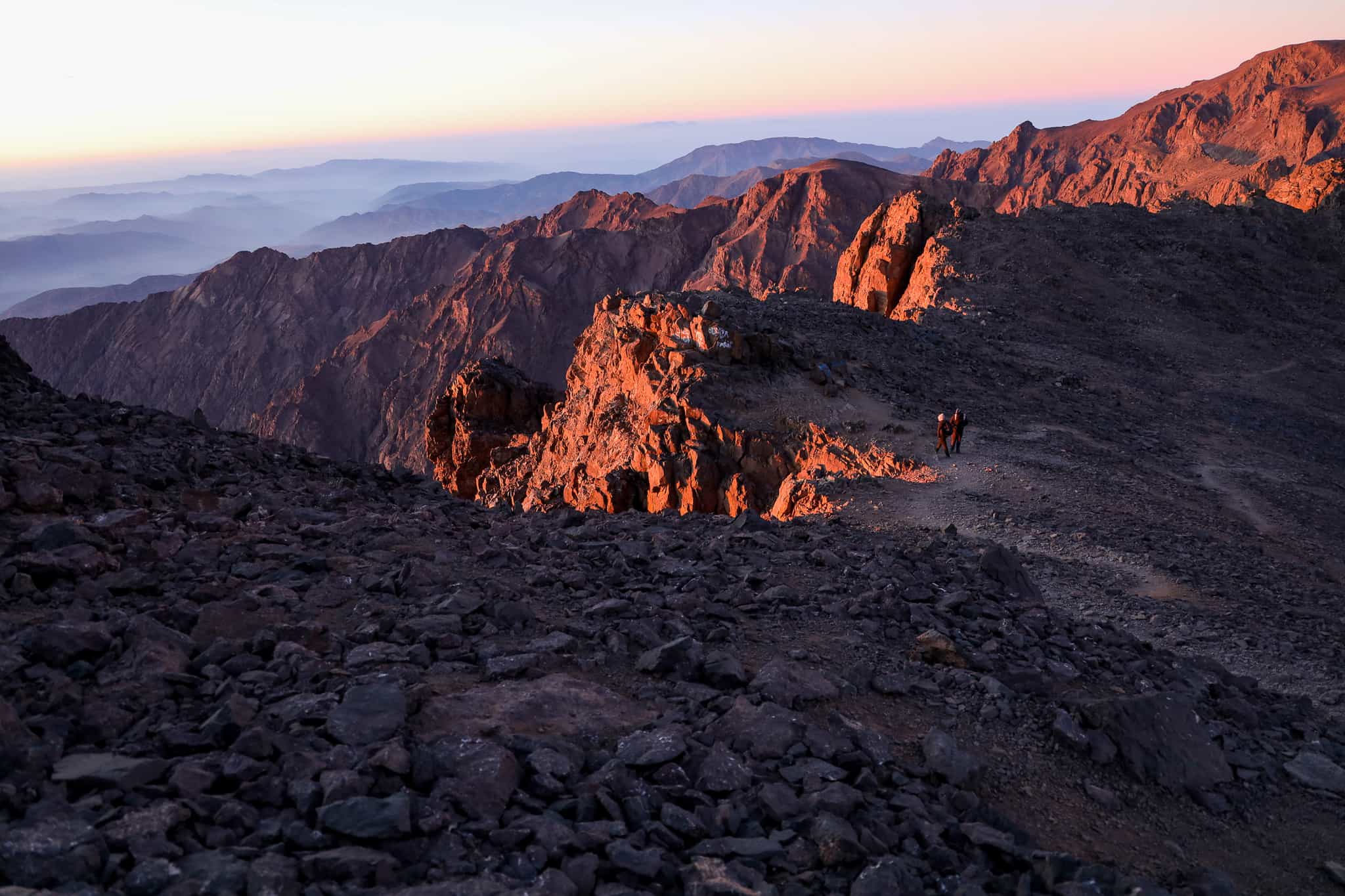
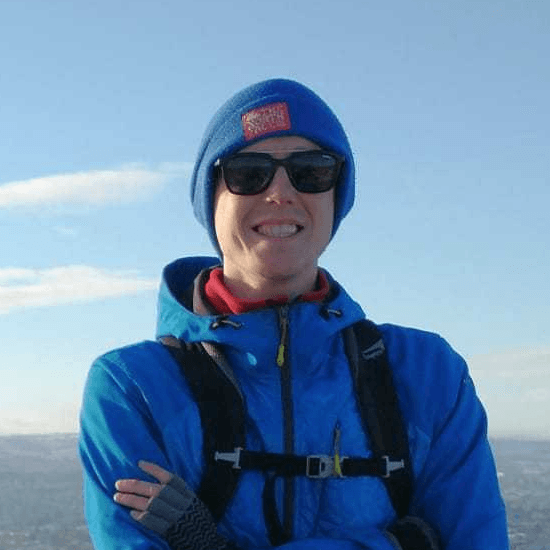
Need help finding flights?
From logistics and how to get there, to fitness, group dynamic and trip difficulty, Rory and his team of friendly experts are on hand to help.
We've got your back
Guaranteed to run
All Much Better Adventures trips are now guaranteed to run. Once you’ve booked your spot you can immediately make your travel arrangements, no uncertainty, no hanging about (excludes 'request to book' departures). Full details
Flexible payments
Secure your spot with the minimum deposit and pay off the remaining balance in as many instalments as you like, with no interest or fees. Full details
Happiness Guarantee
We’re so confident you’ll have an amazing time we’ll put our money on it. Full details
Full financial protection
To give you complete peace of mind Much Better Adventures is backed by ABTOT, ABTA and ATOL memberships. Full details
Tried & Trusted
Much Better Adventures is rated ‘Excellent’ on Trustpilot with over 1000 verified trip reviews averaging 4.8/5.
Connect before you go
You'll be invited to join a WhatsApp group to get to know each other before your big adventure together. Full details
DEPARTURE DATES
Saturday 20th September 2025
to Sunday 5th October 2025
